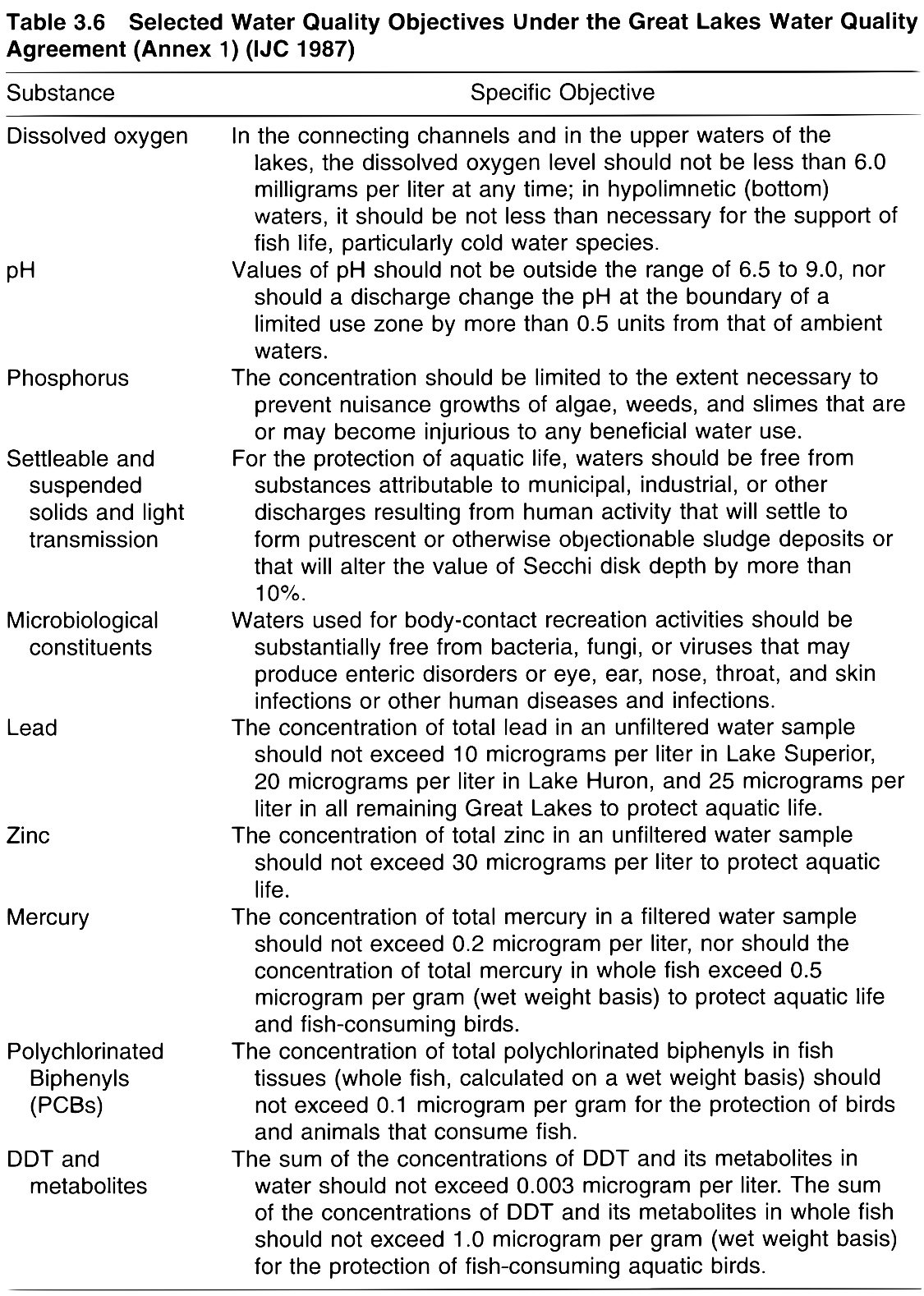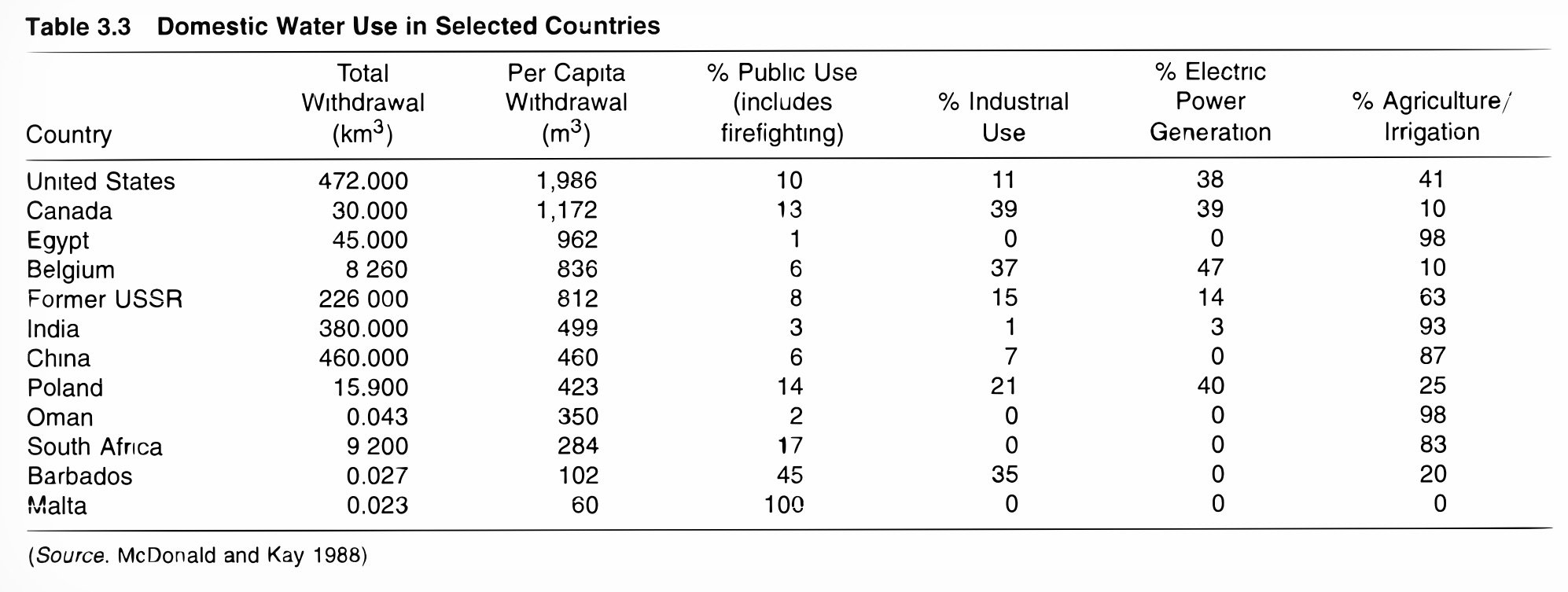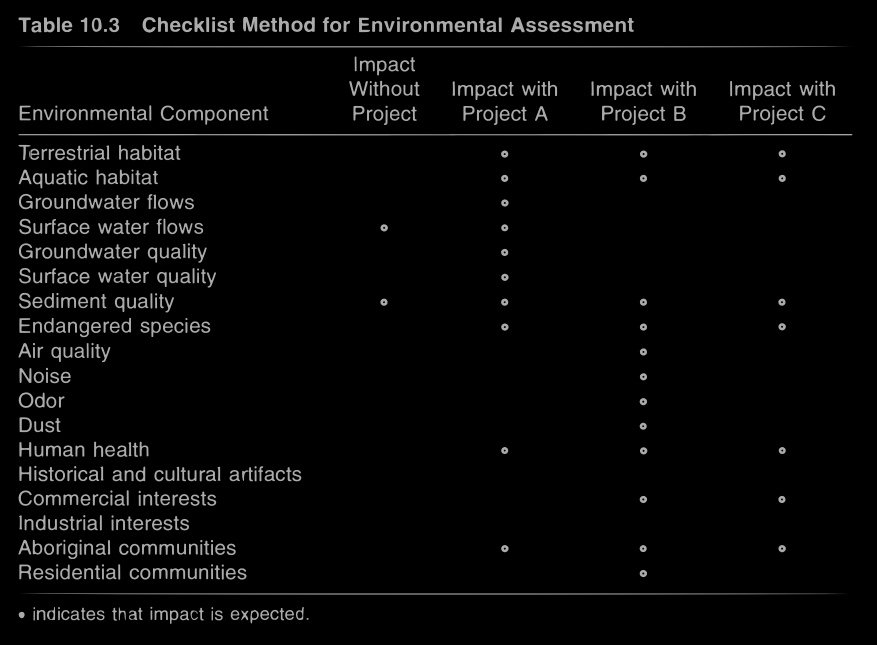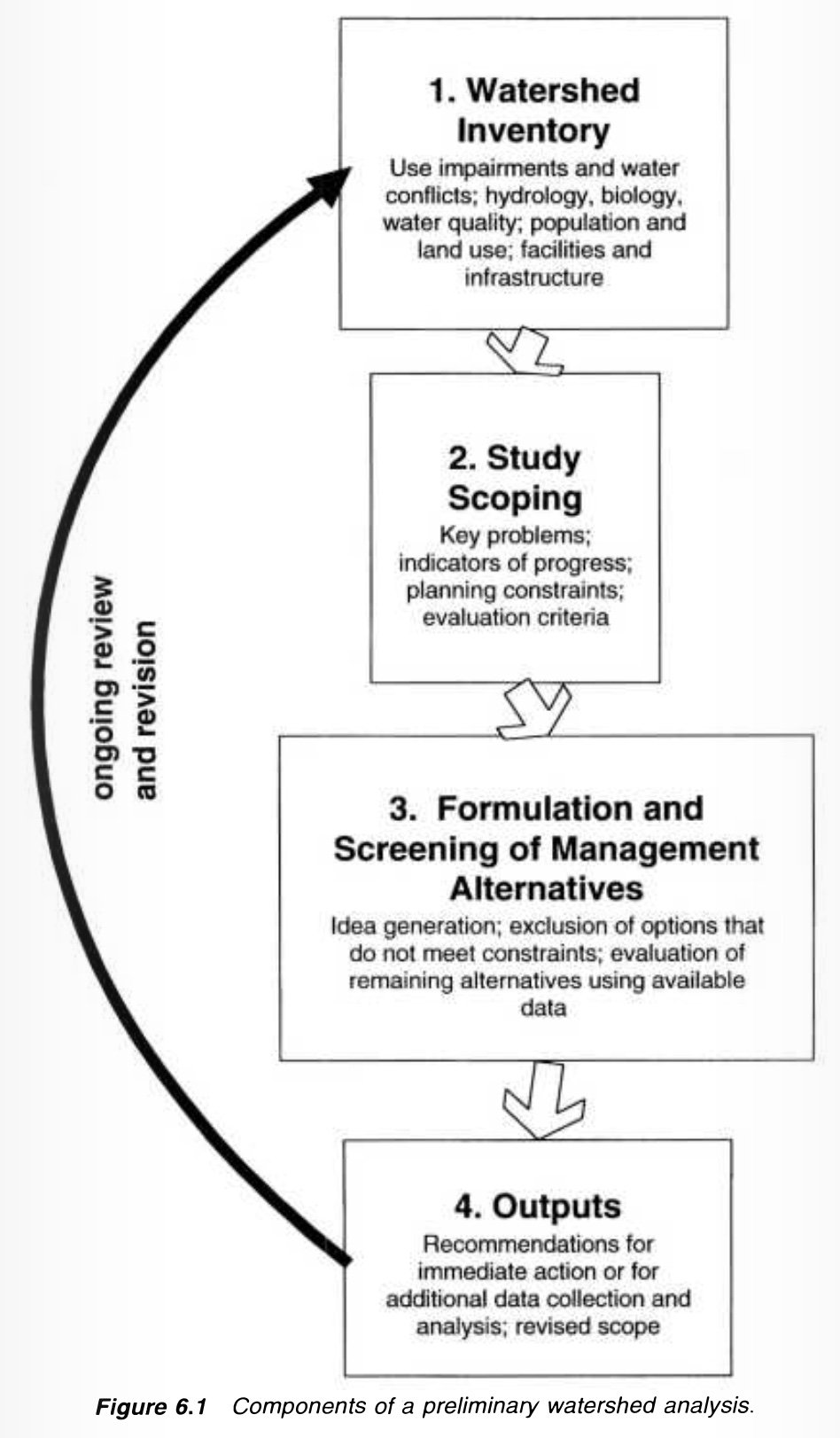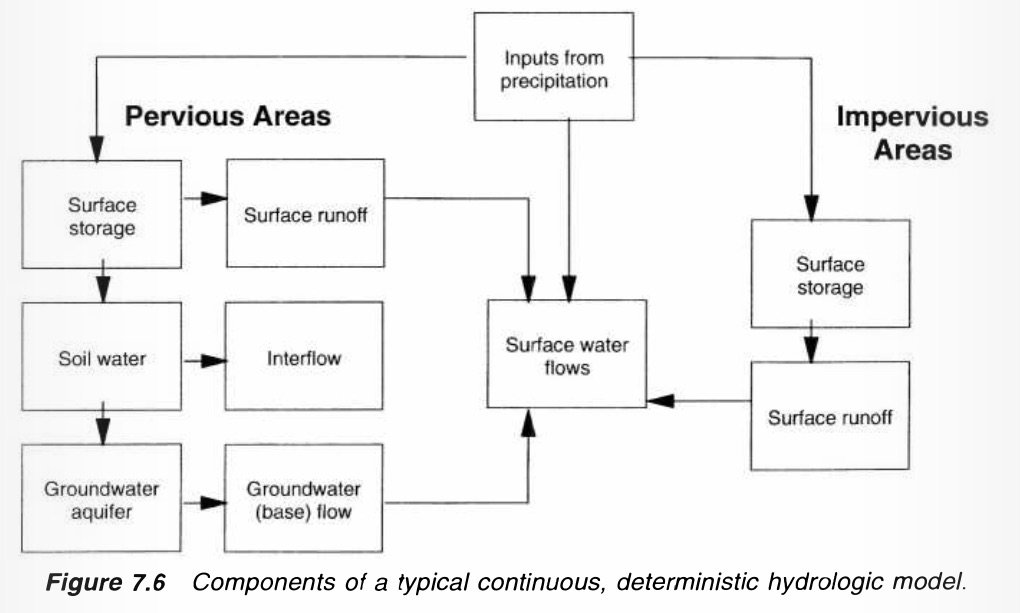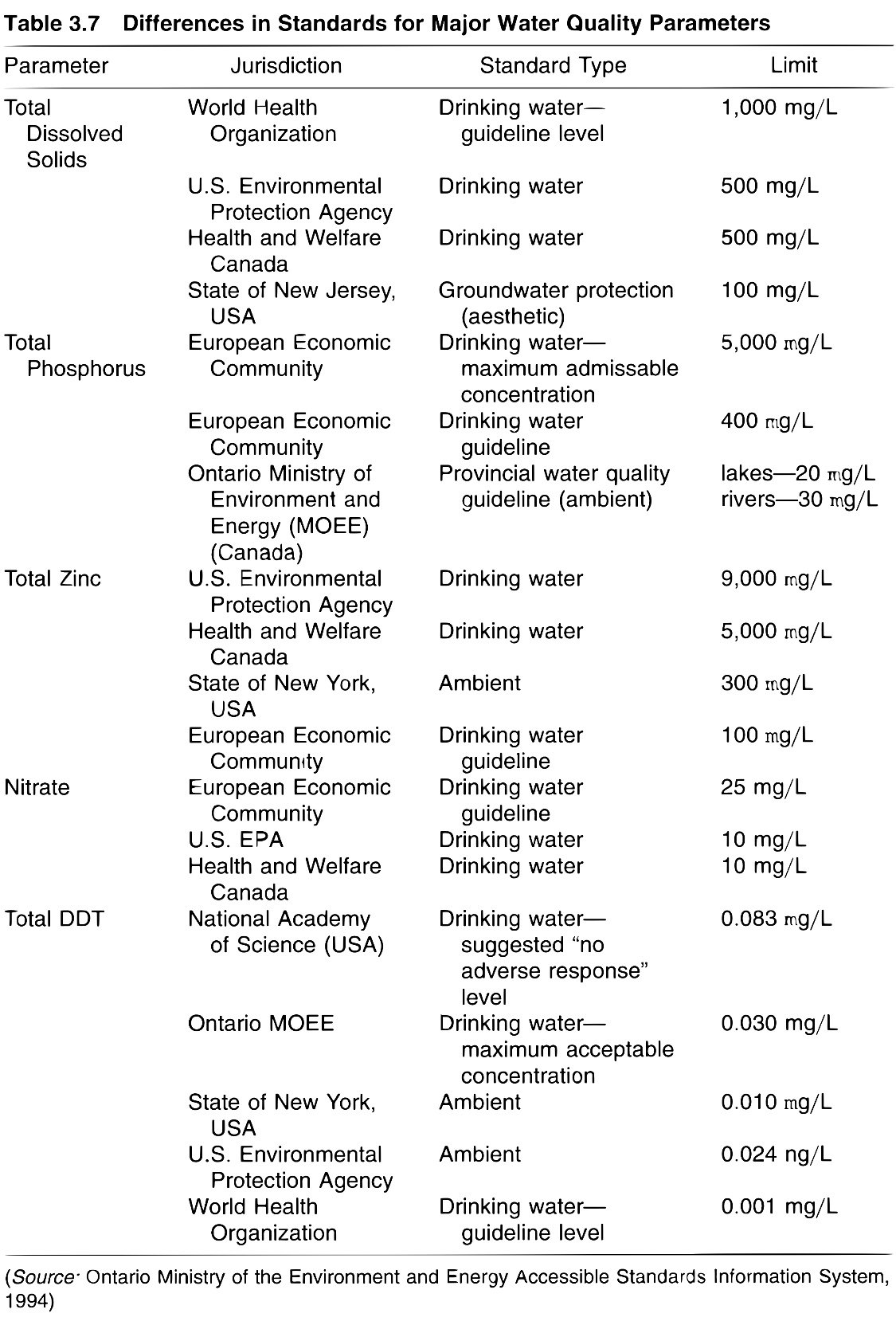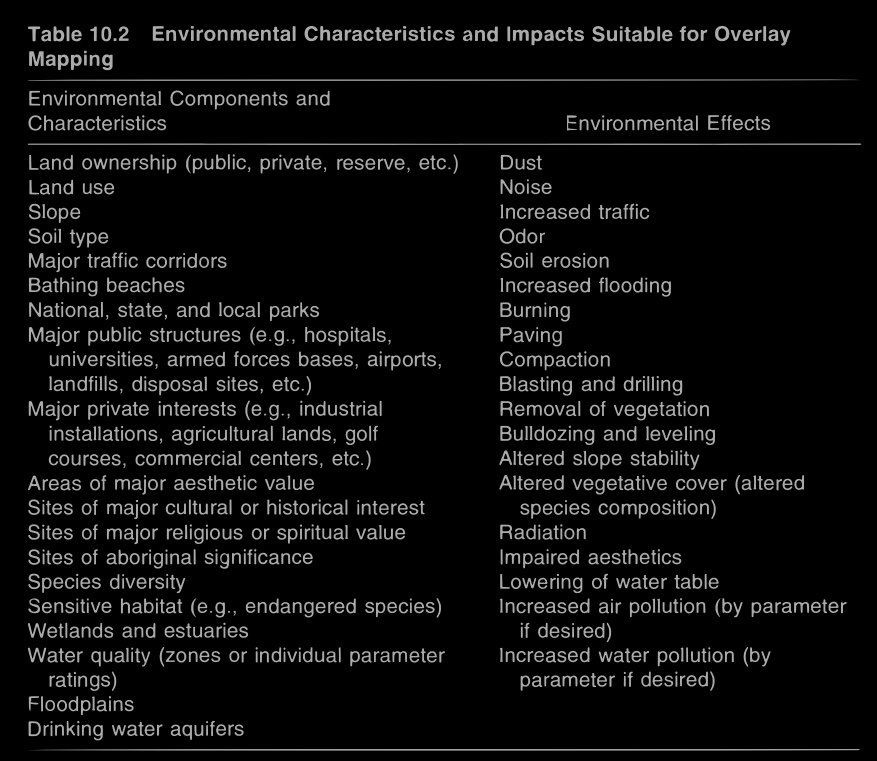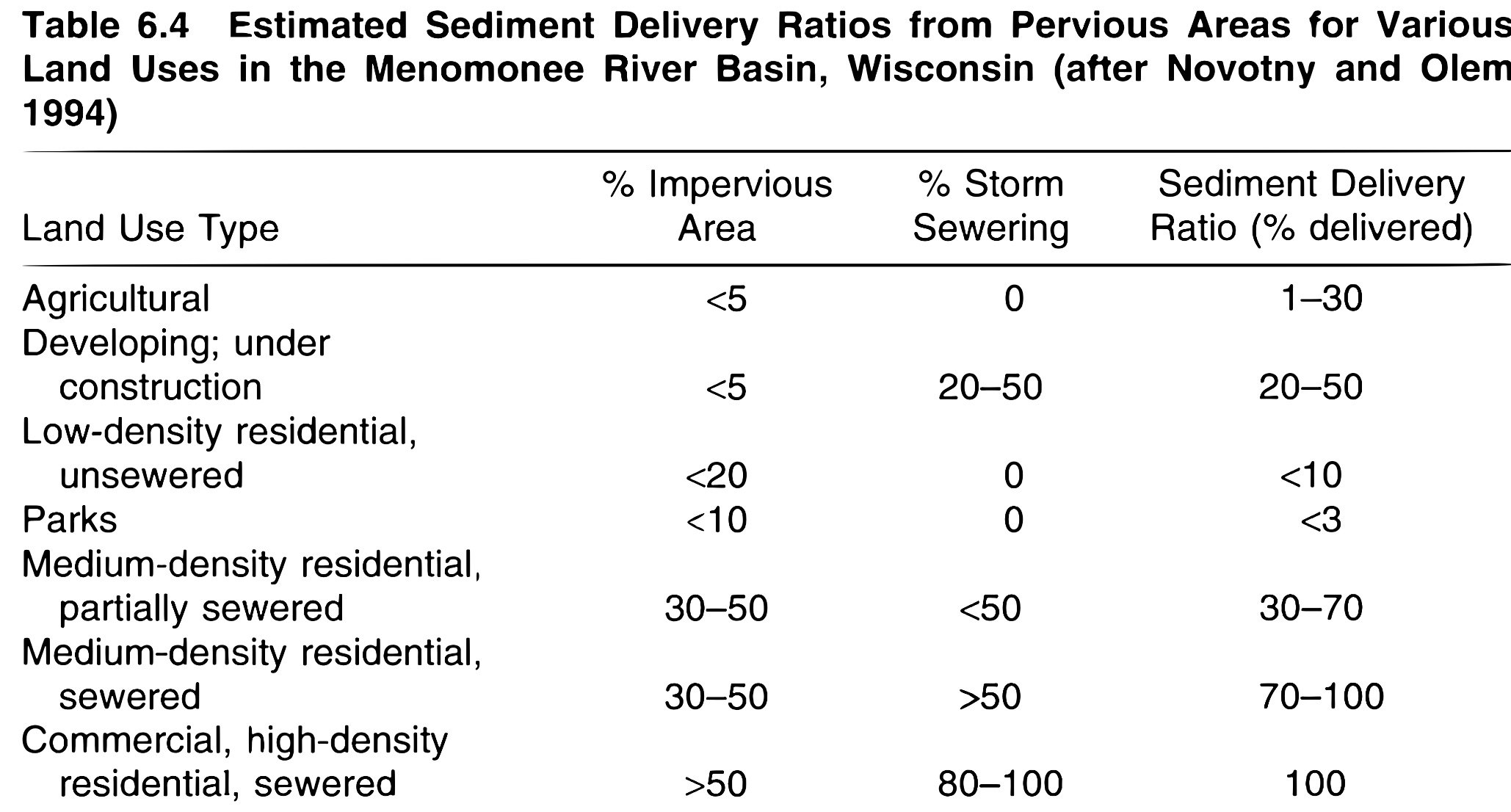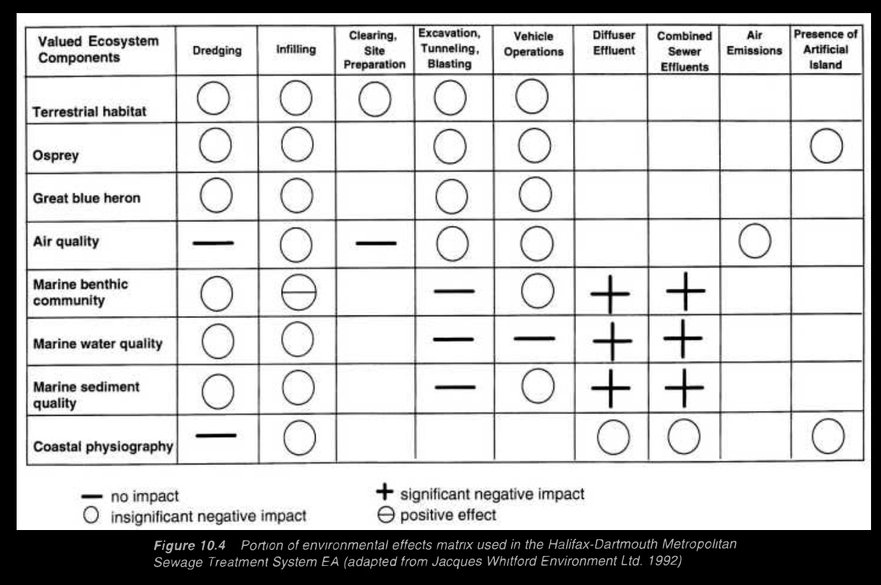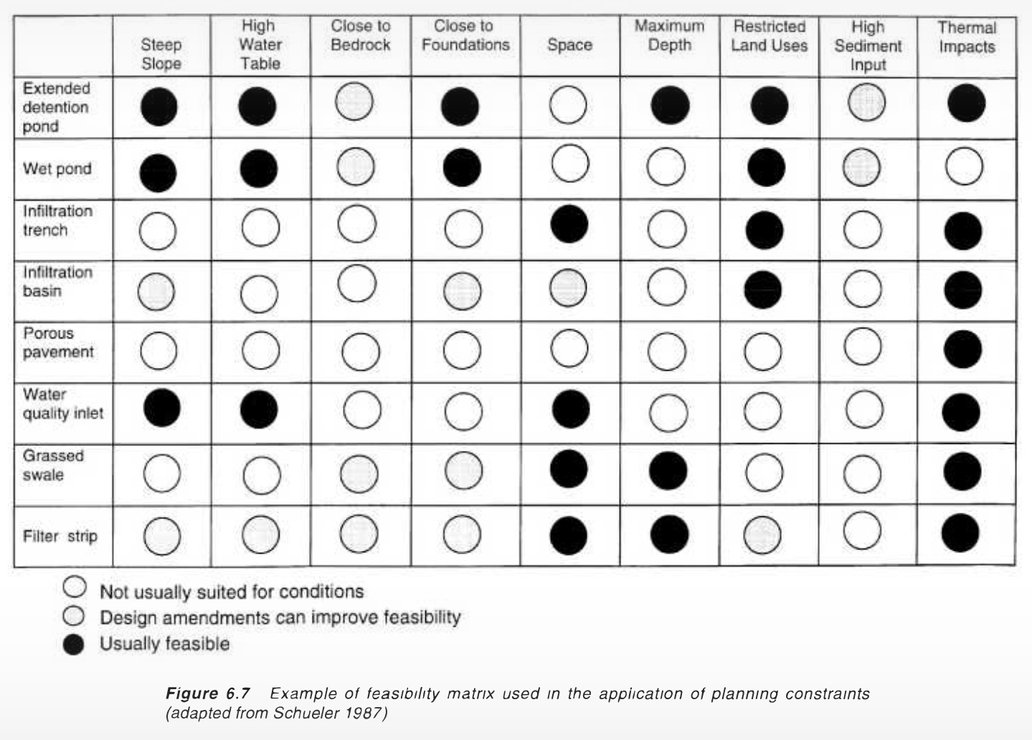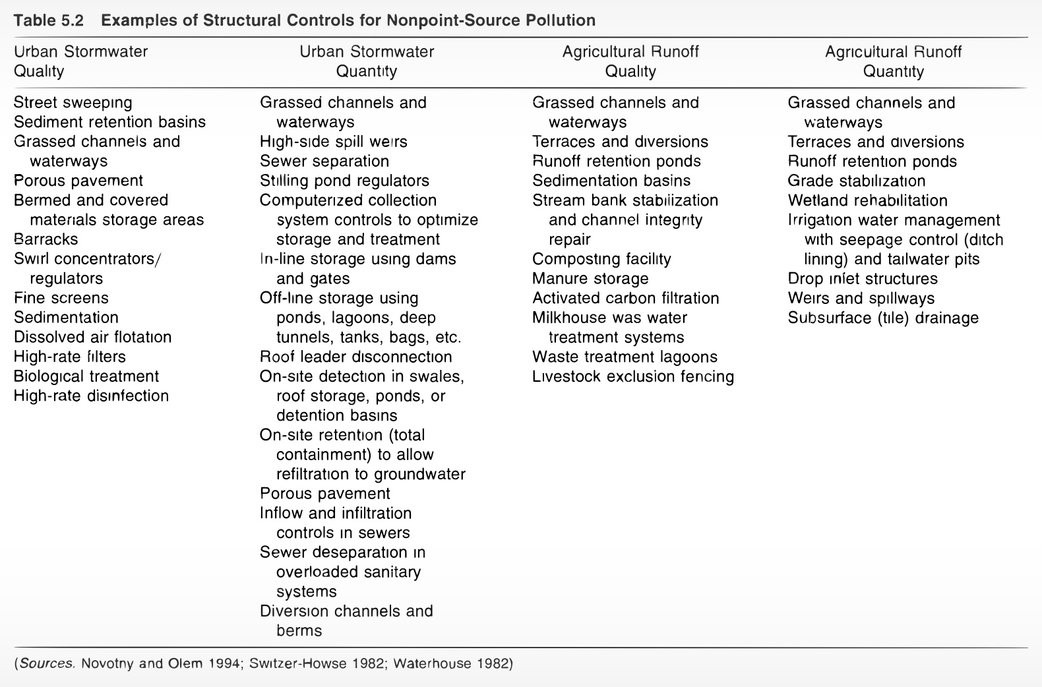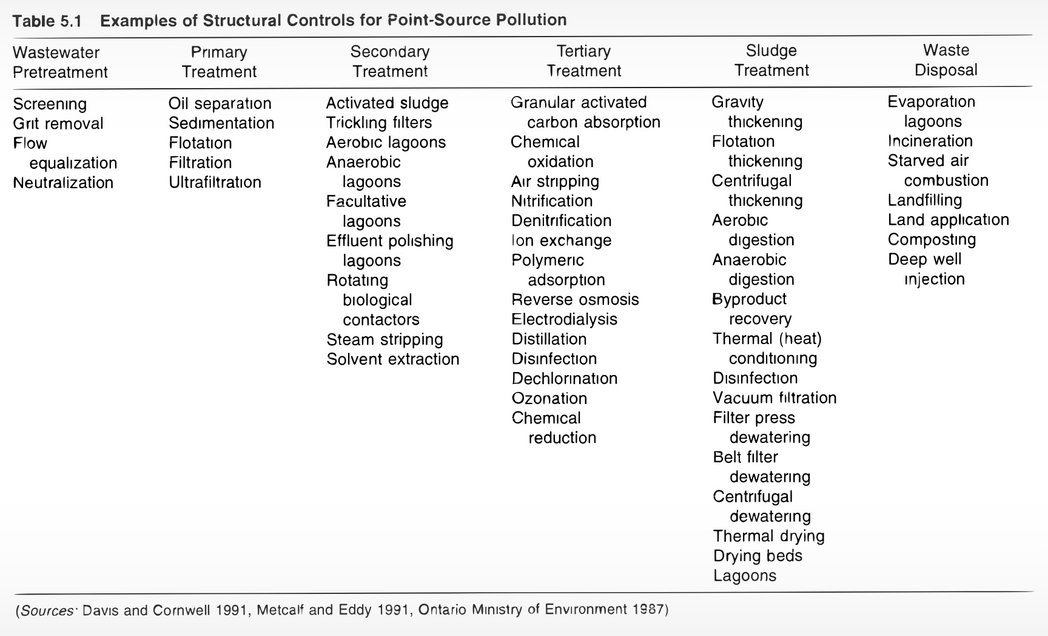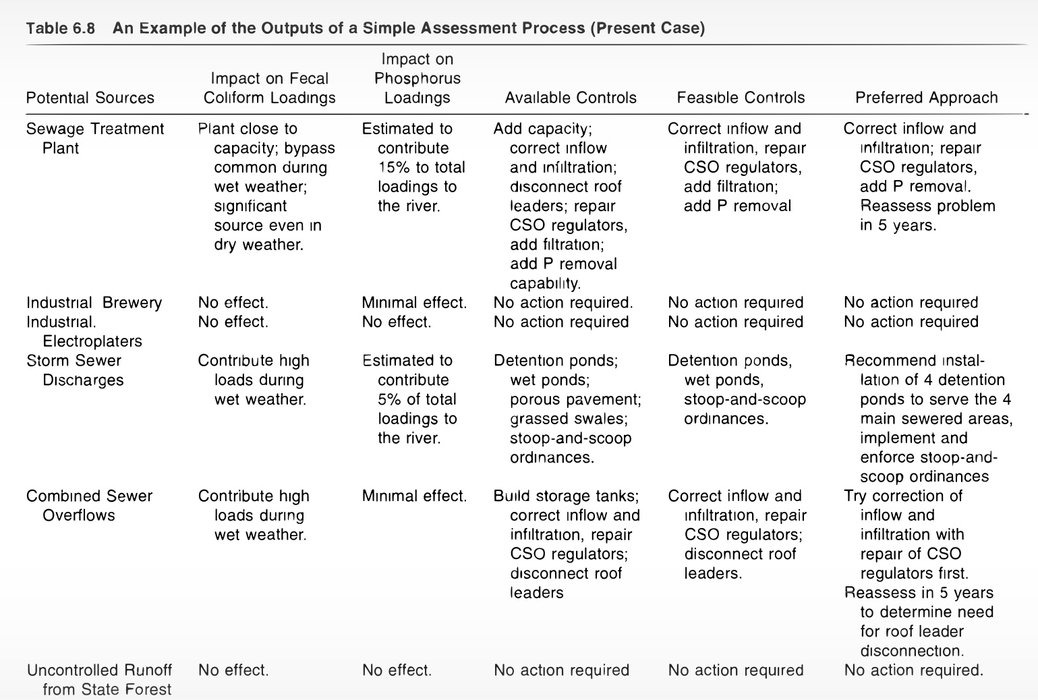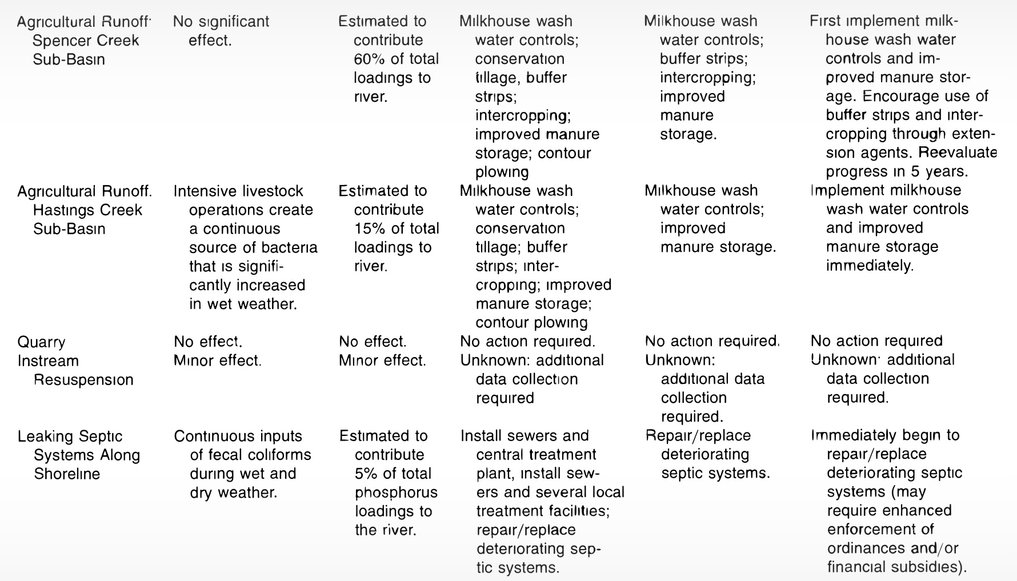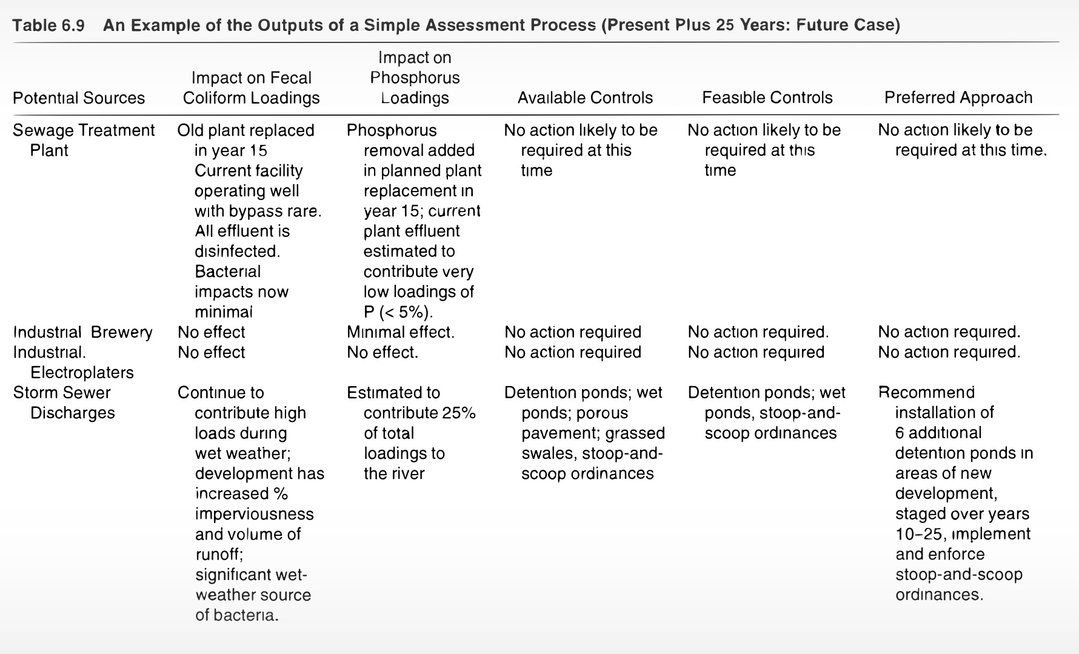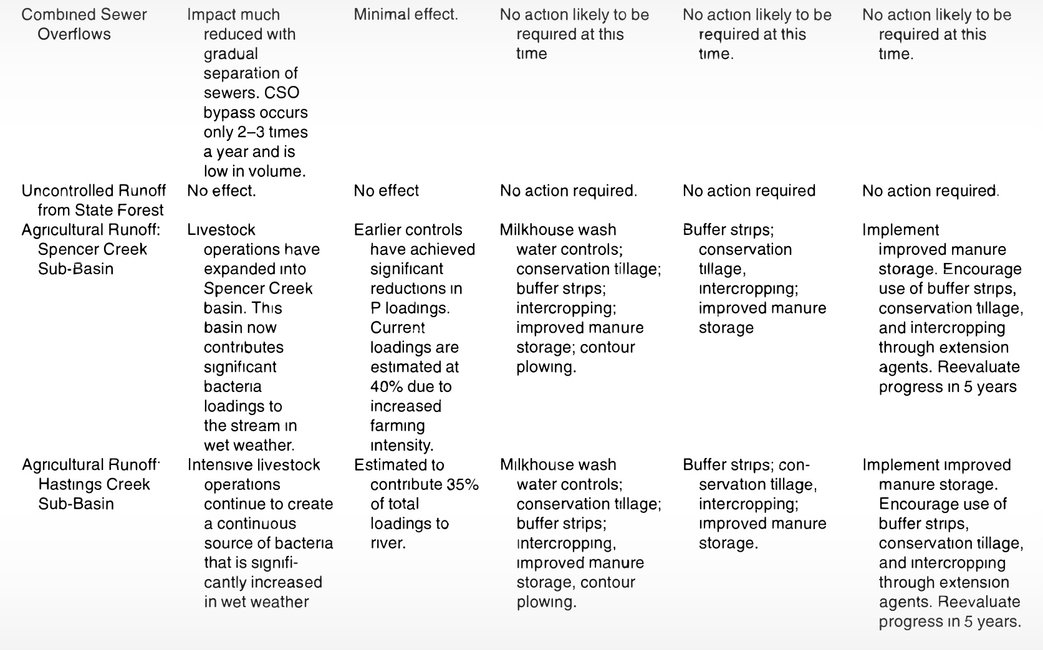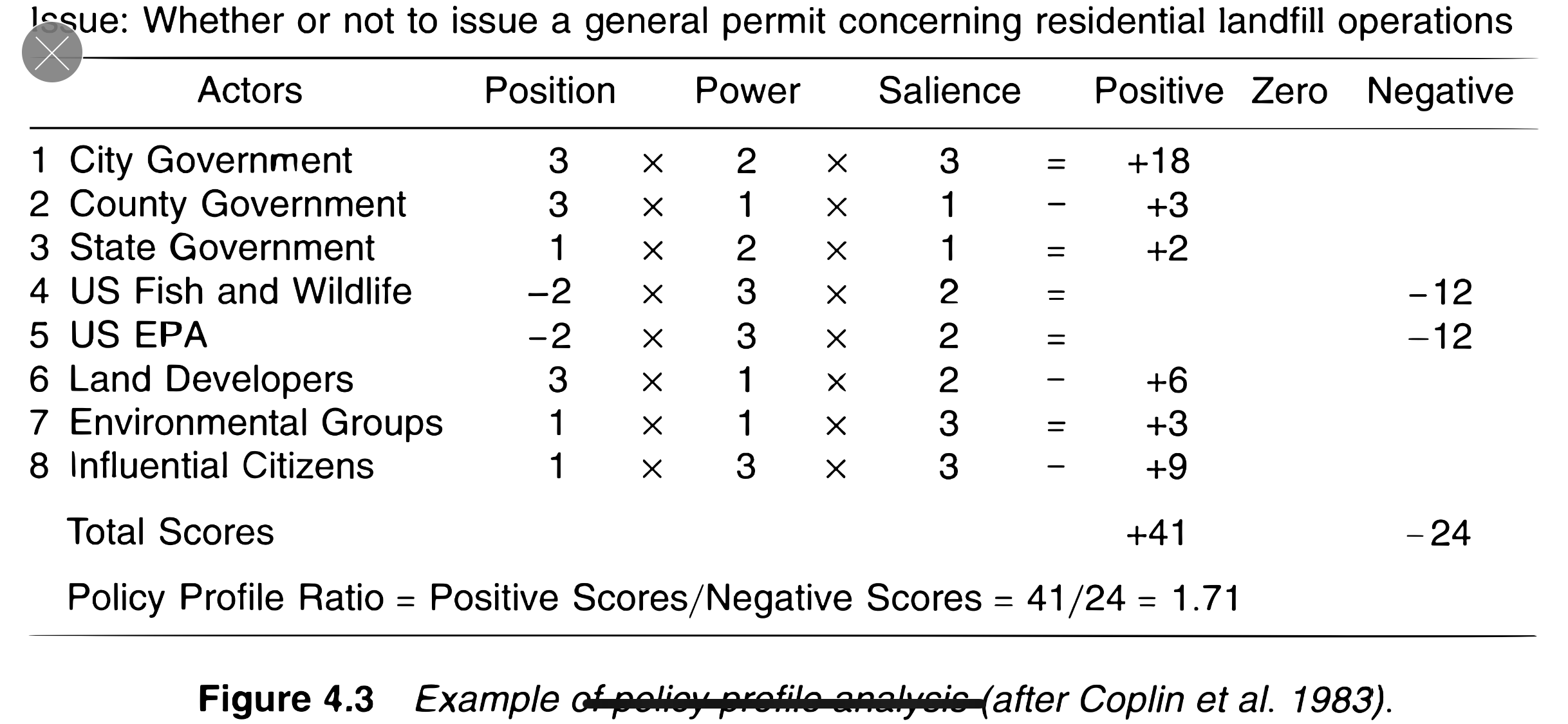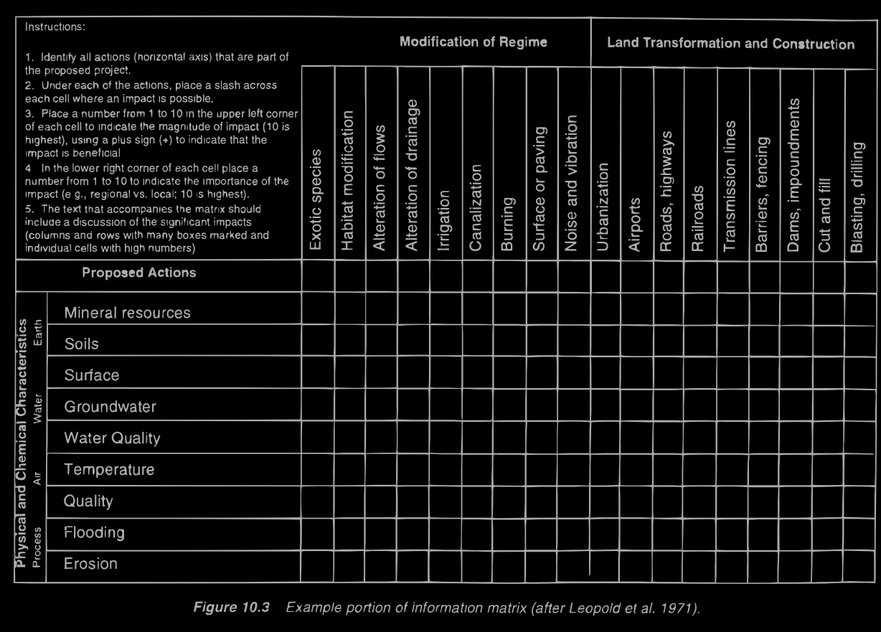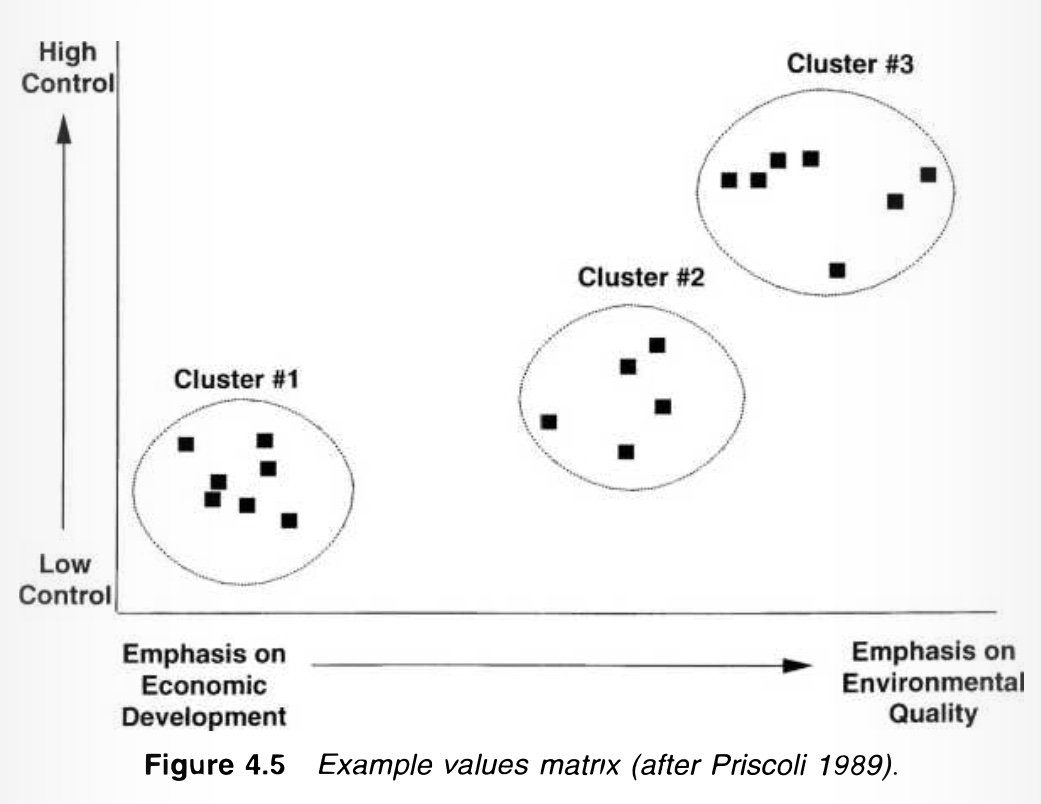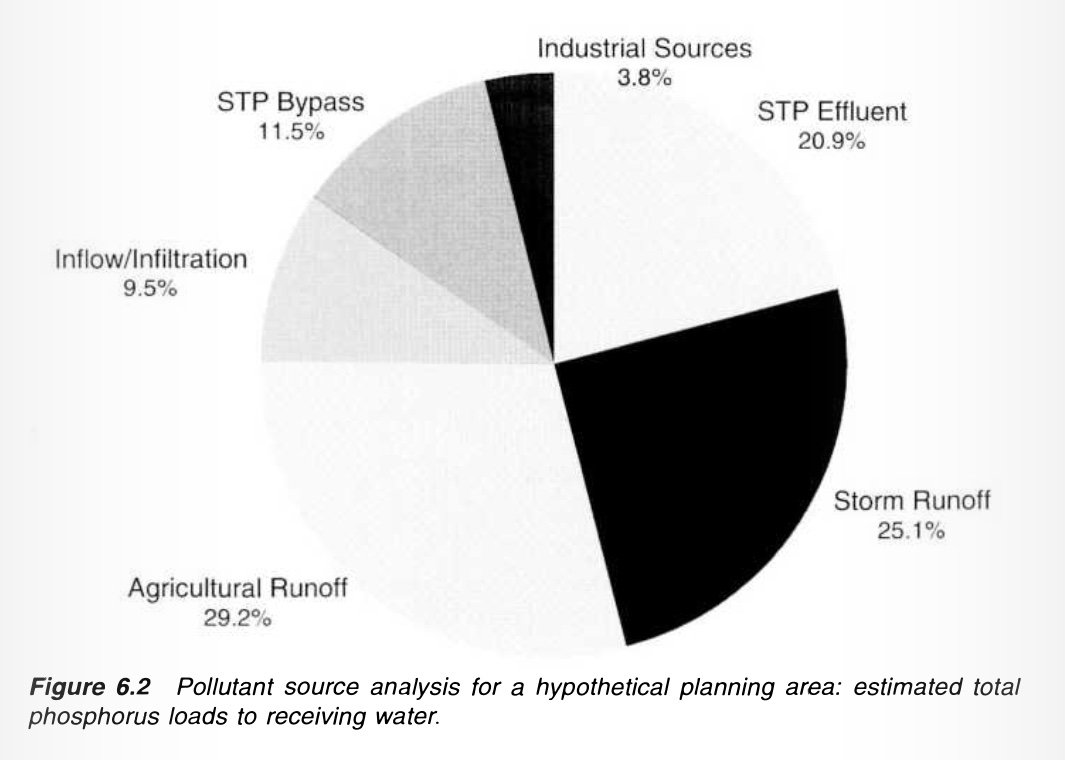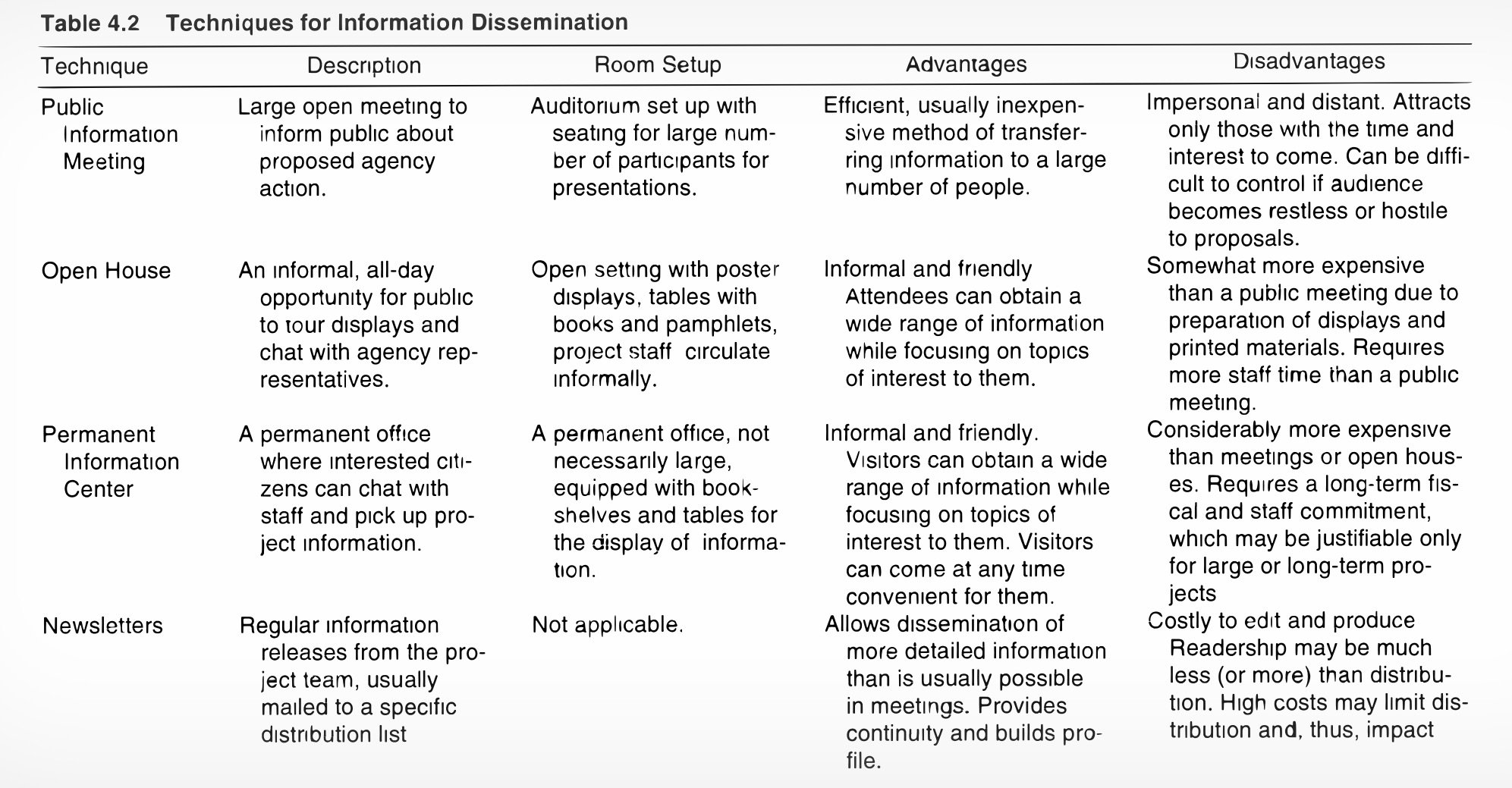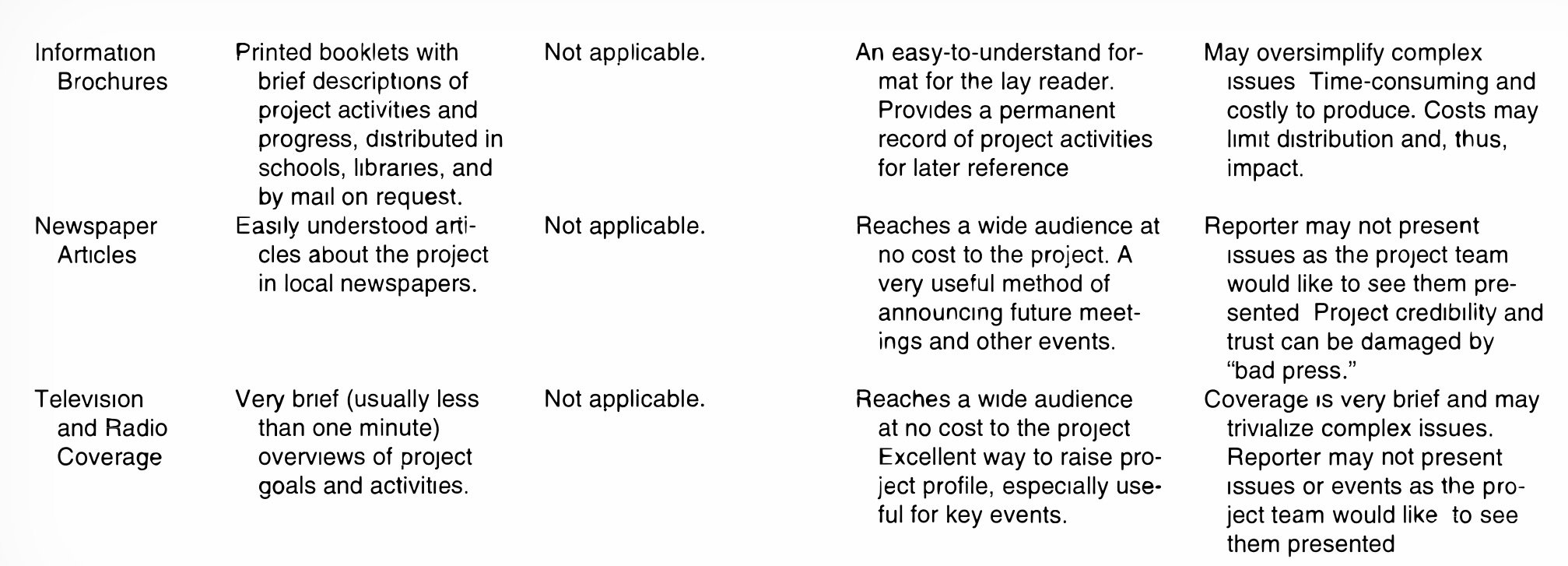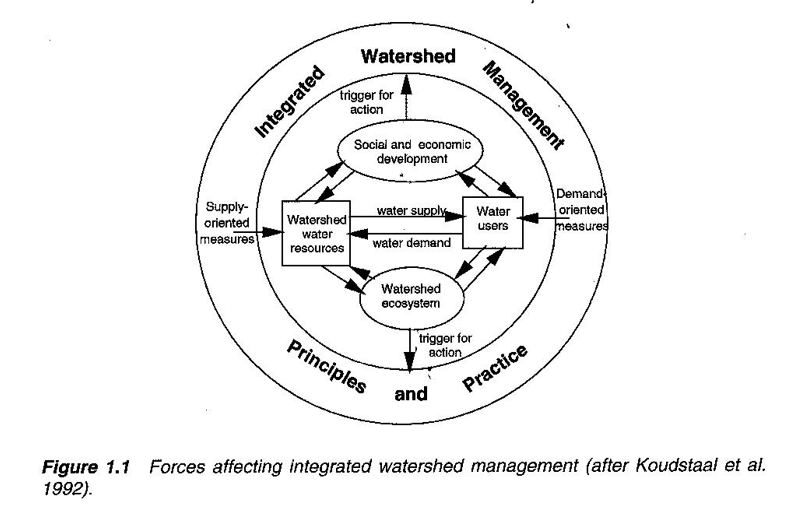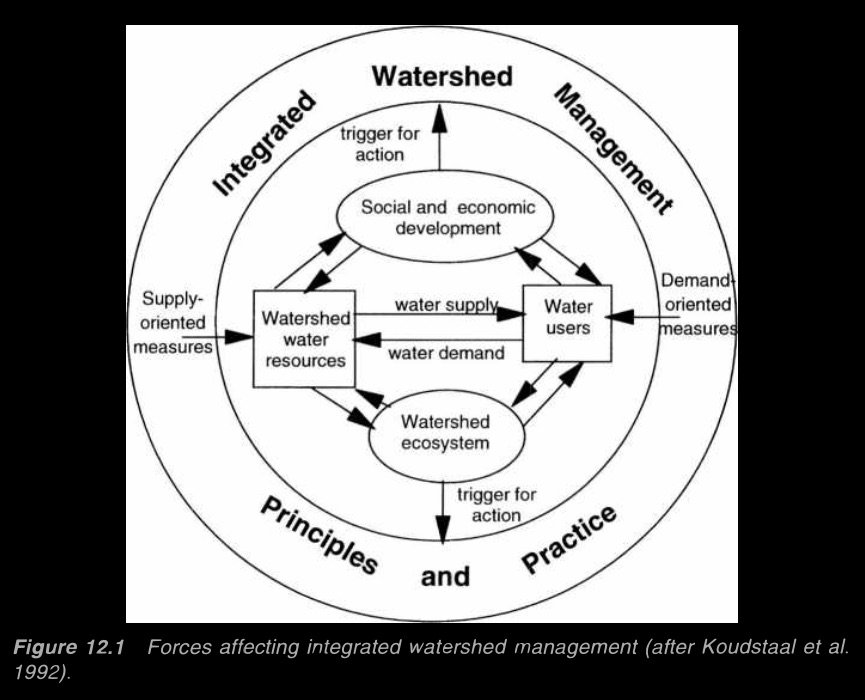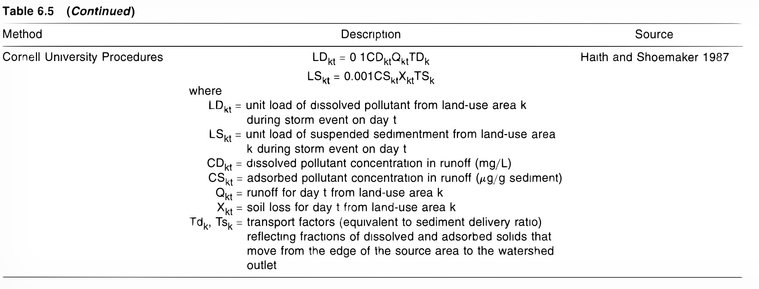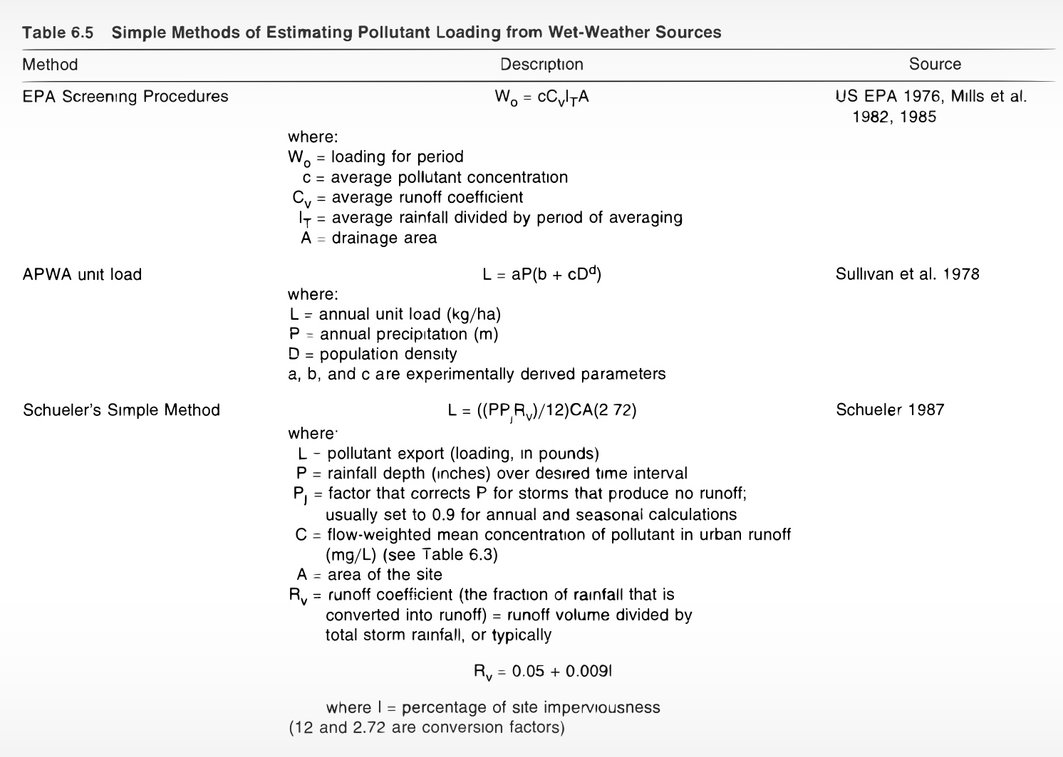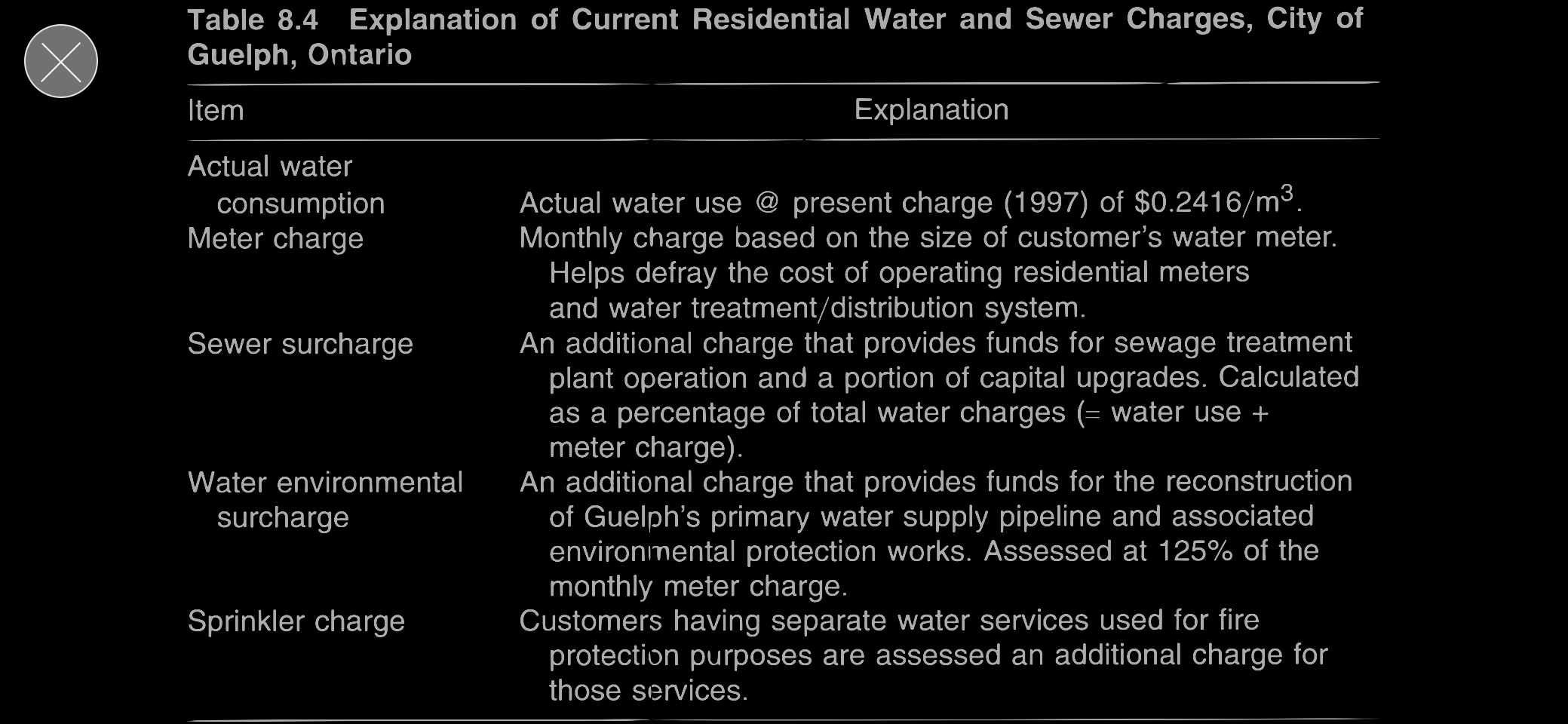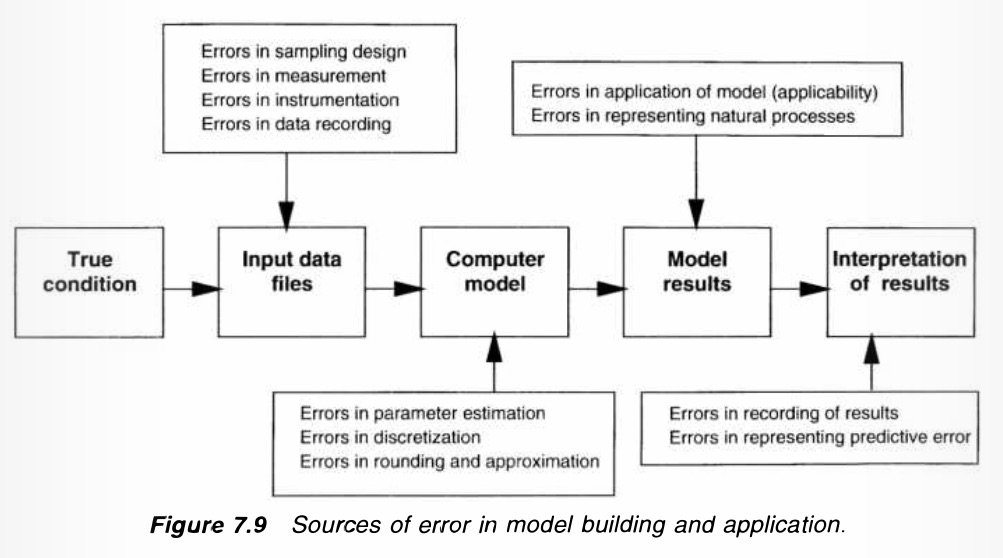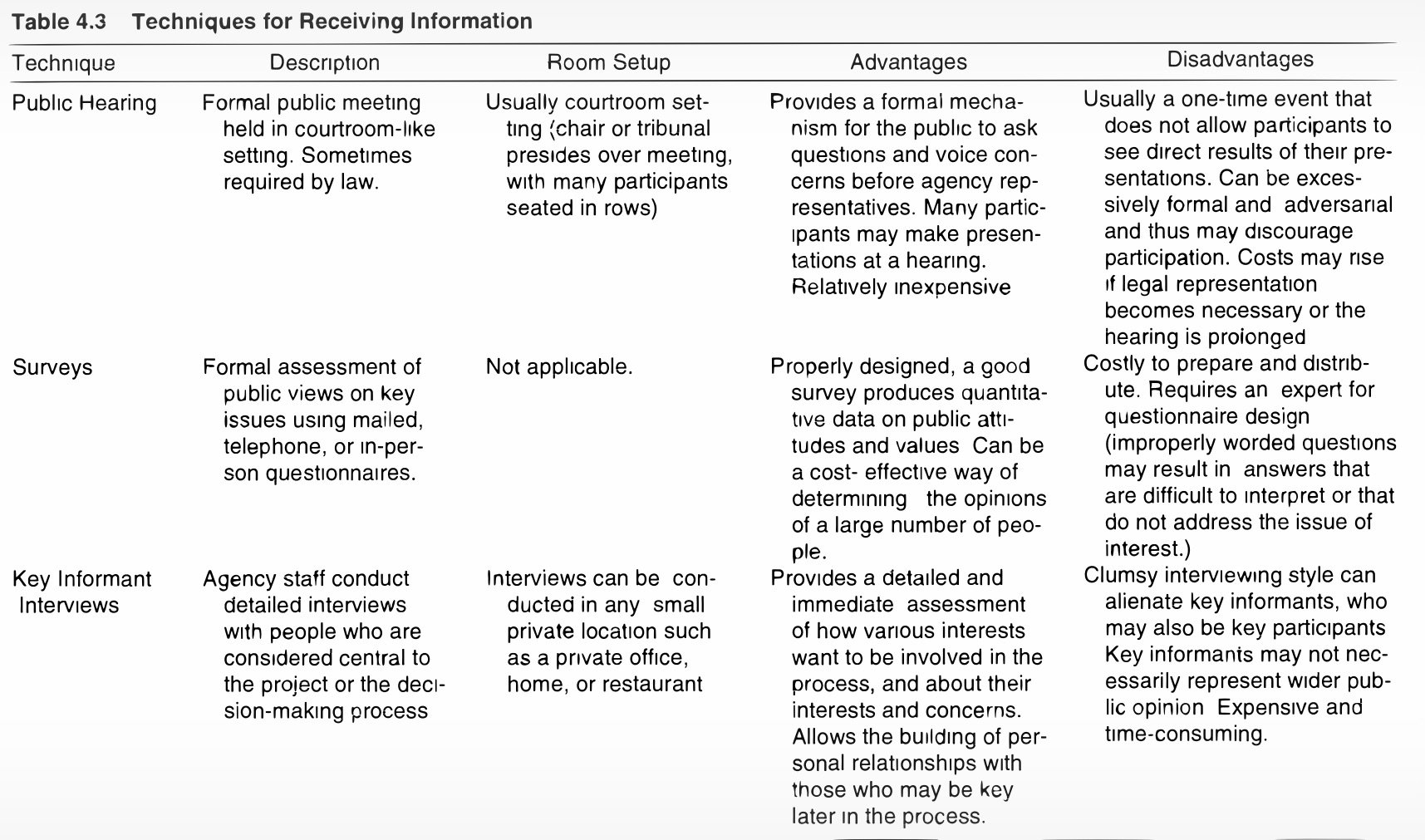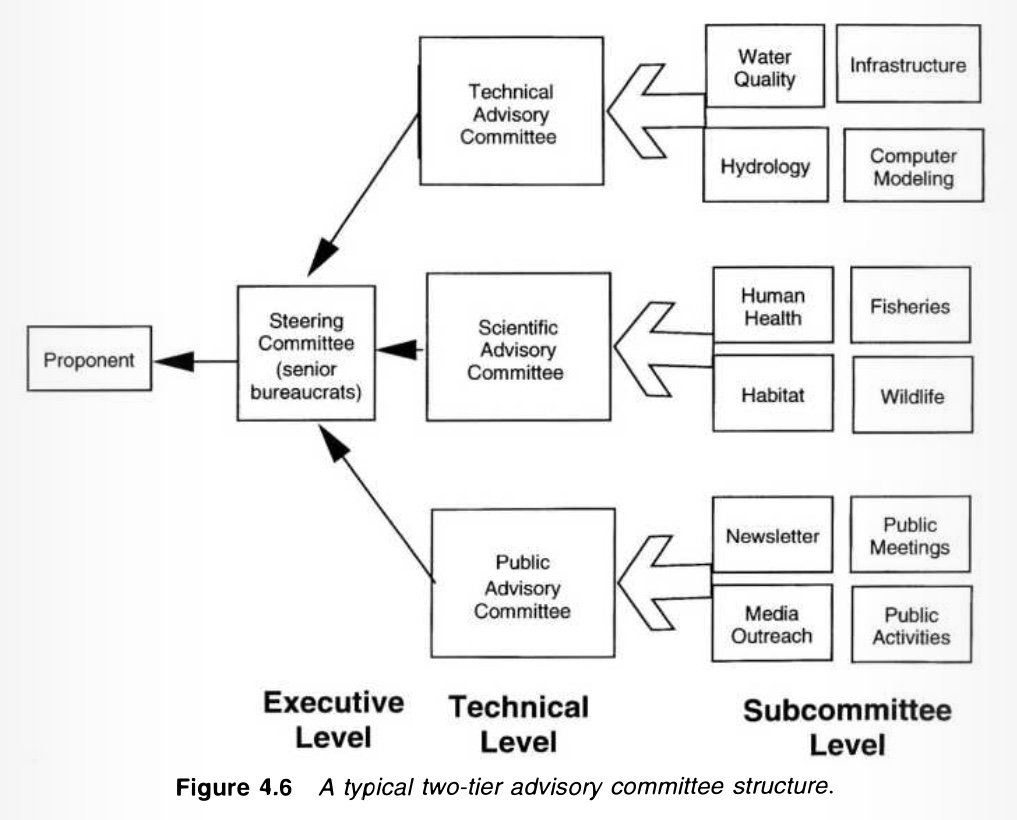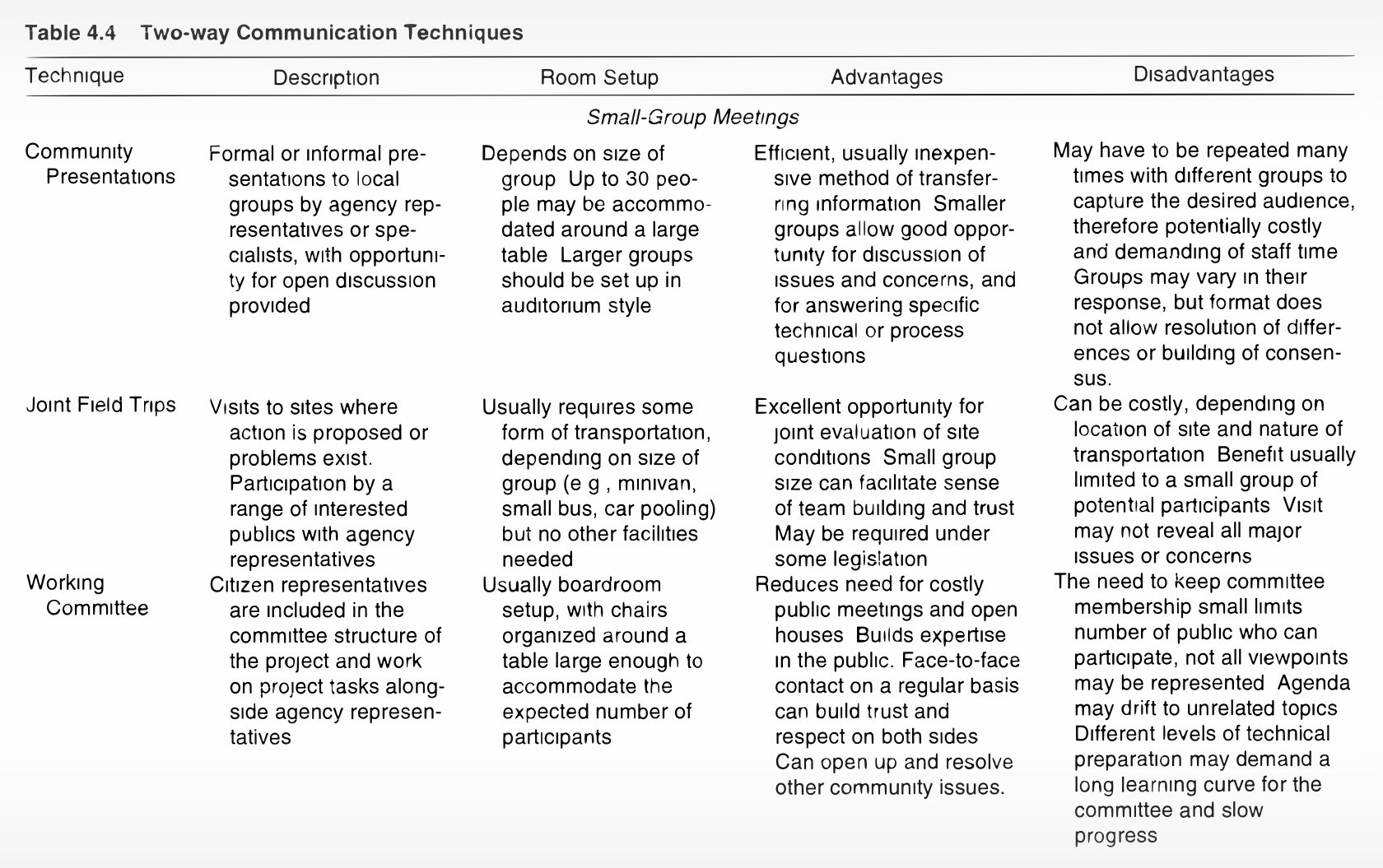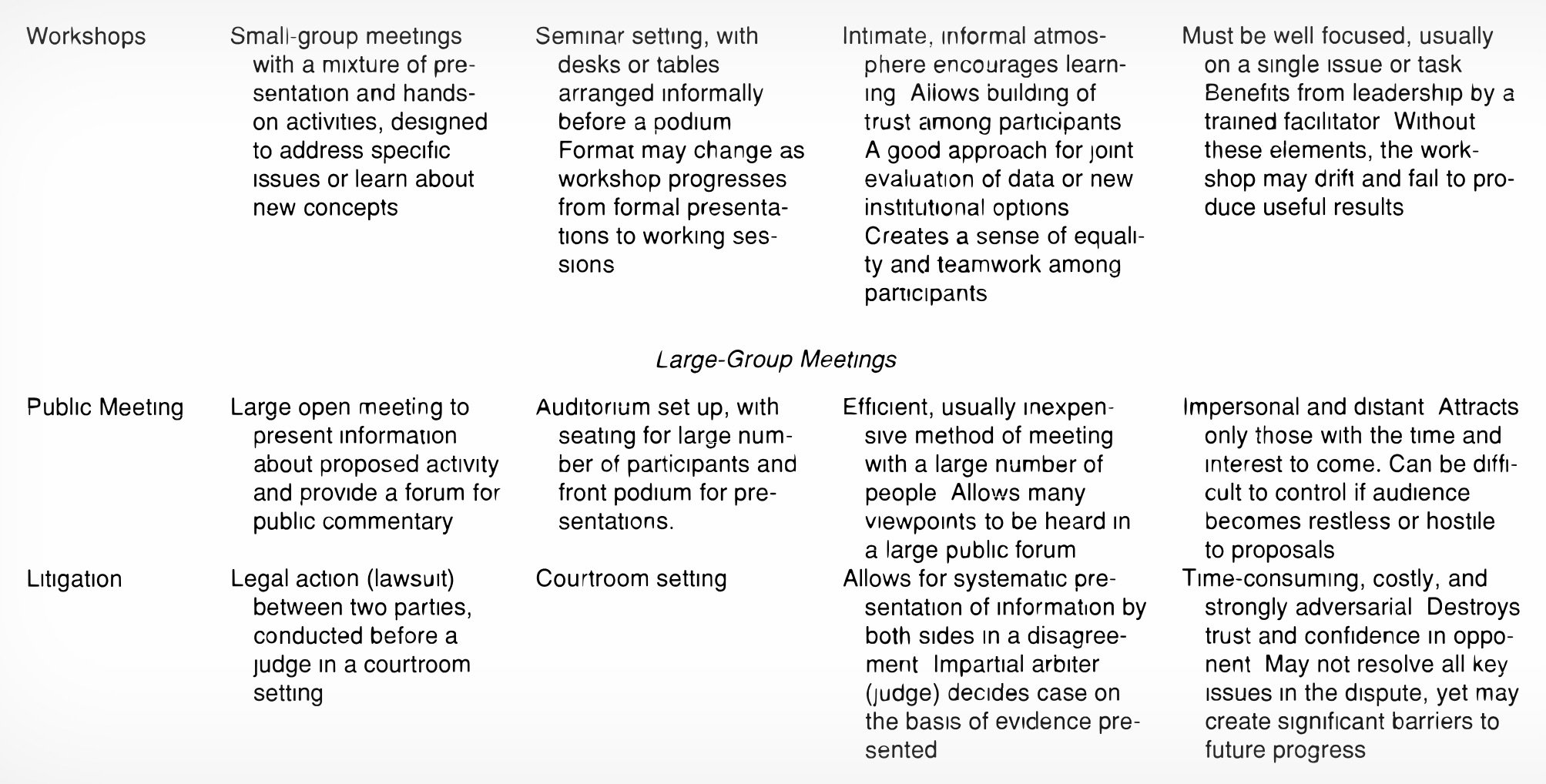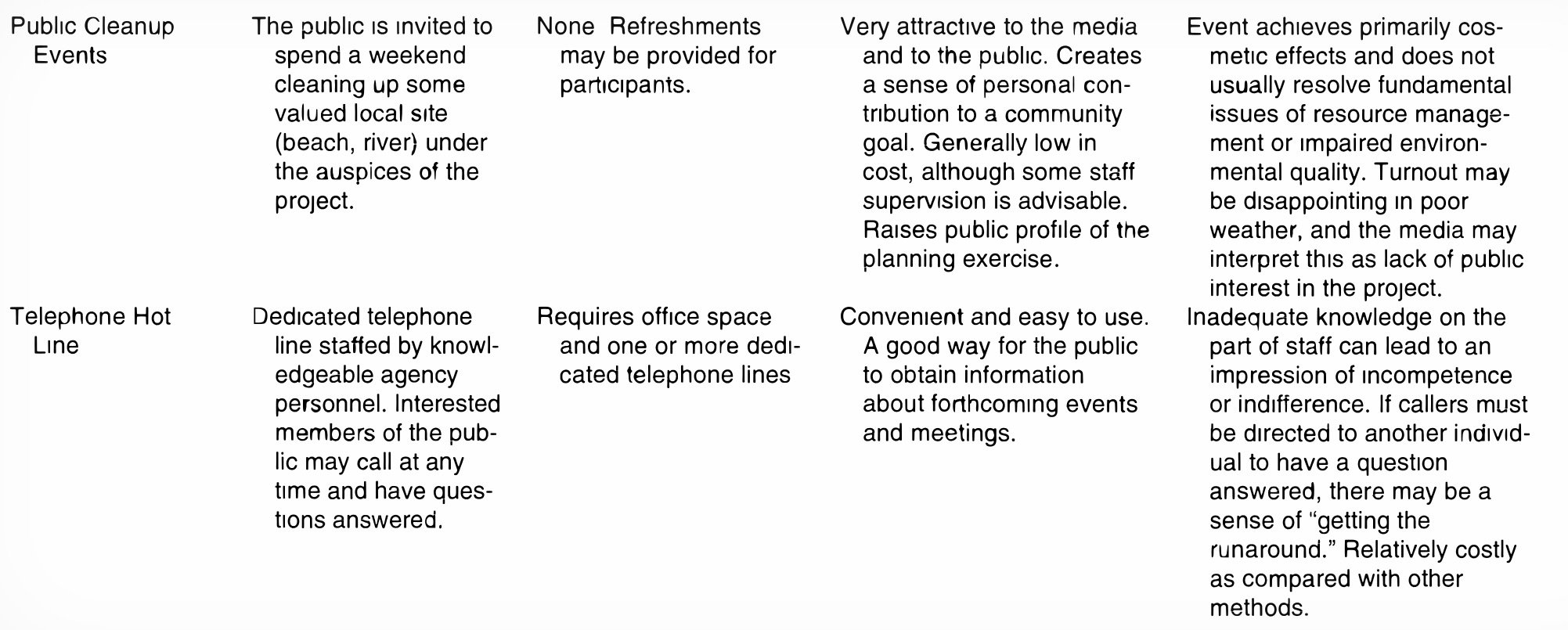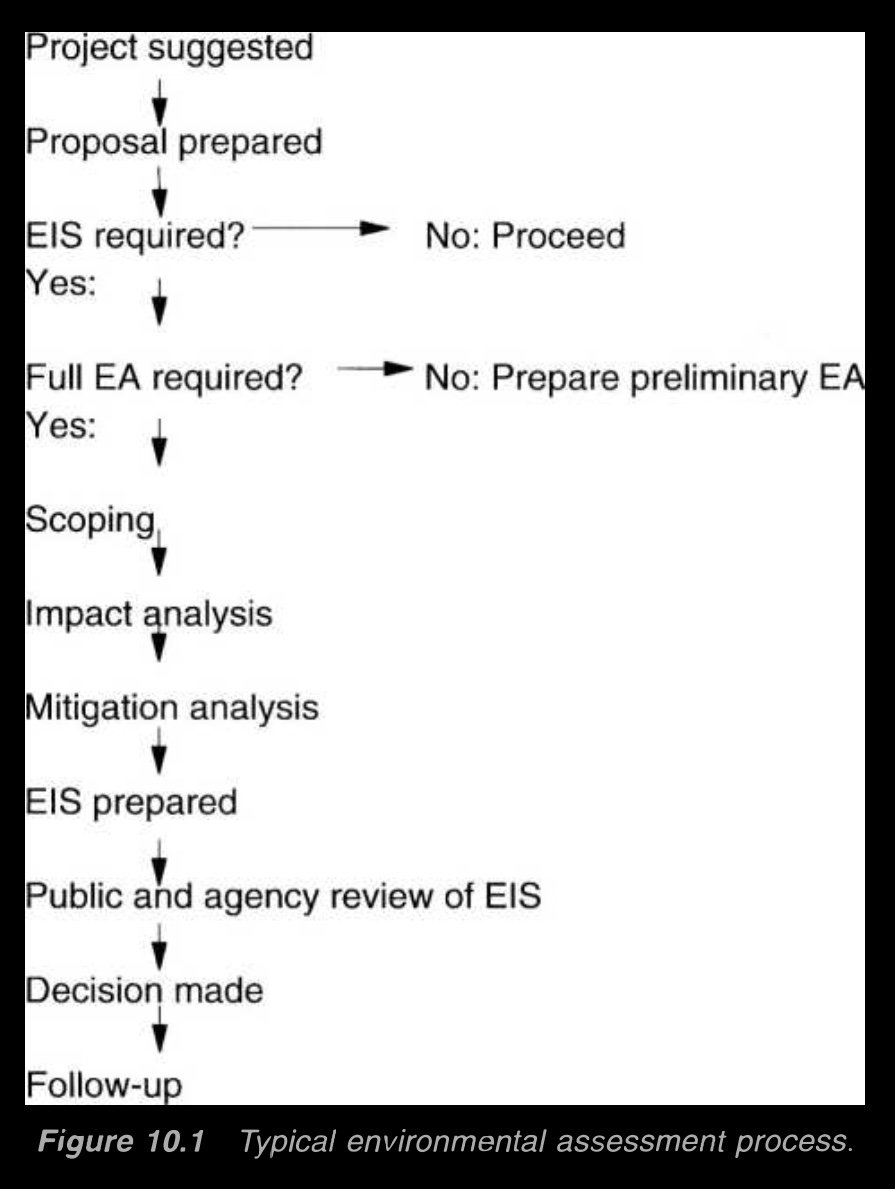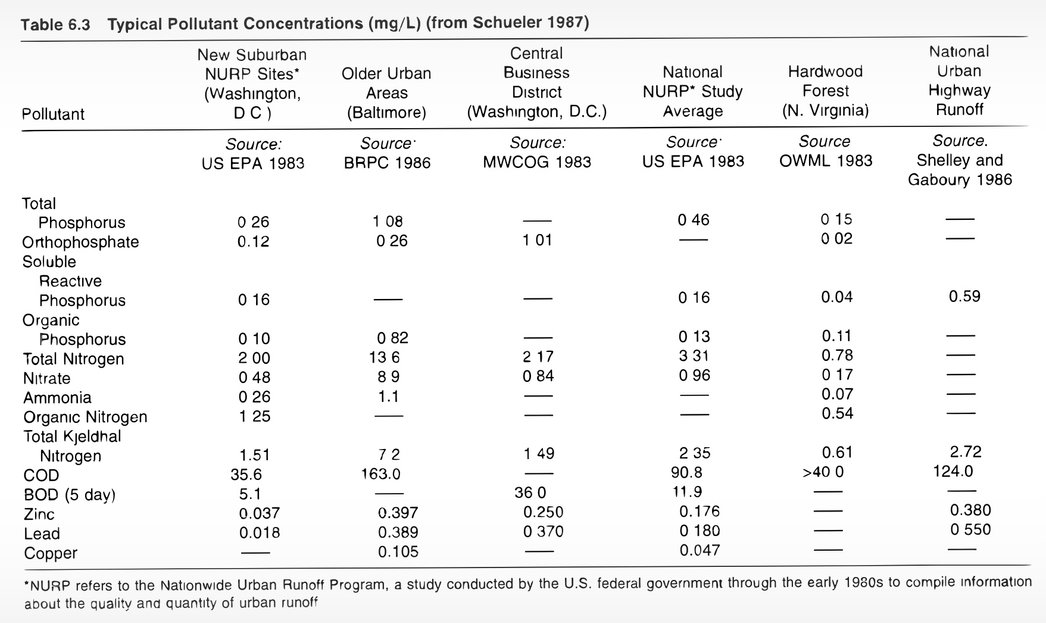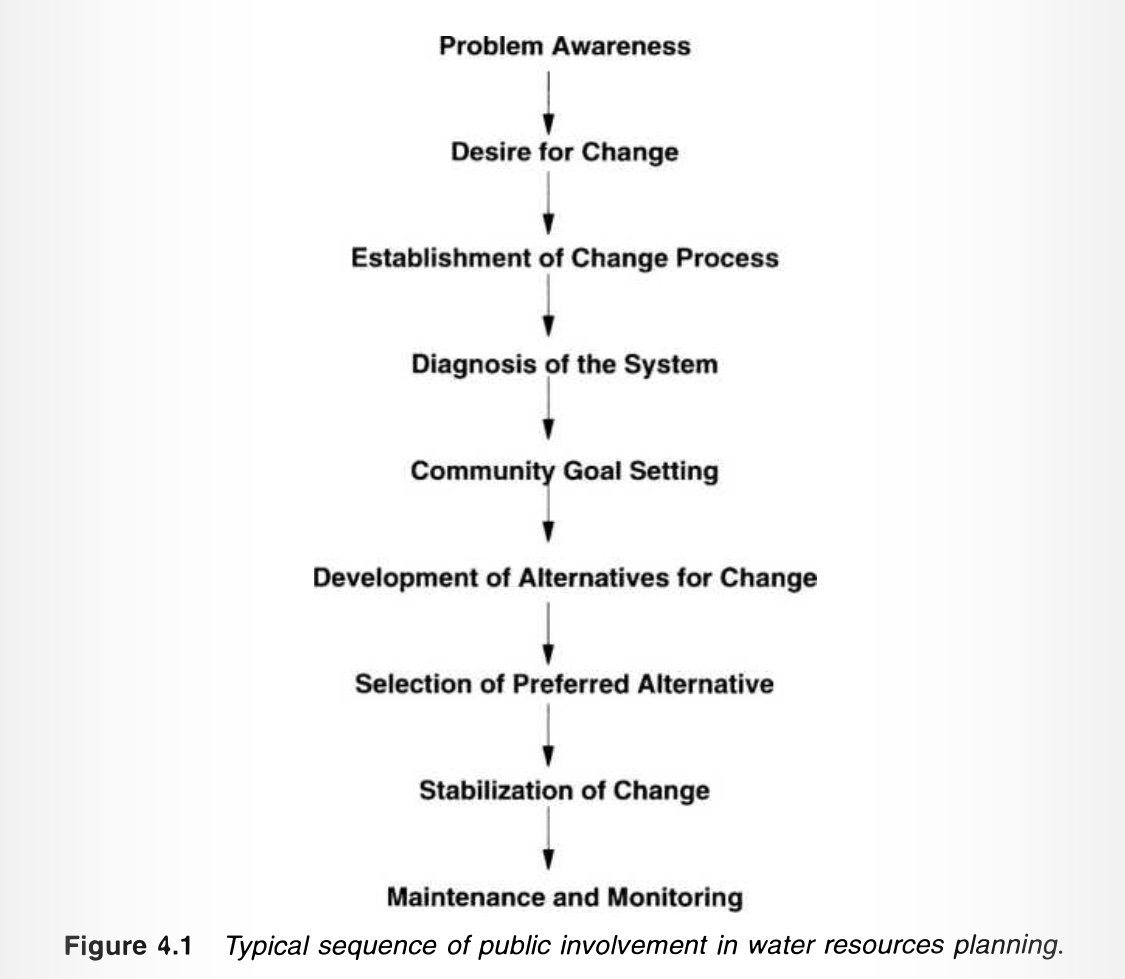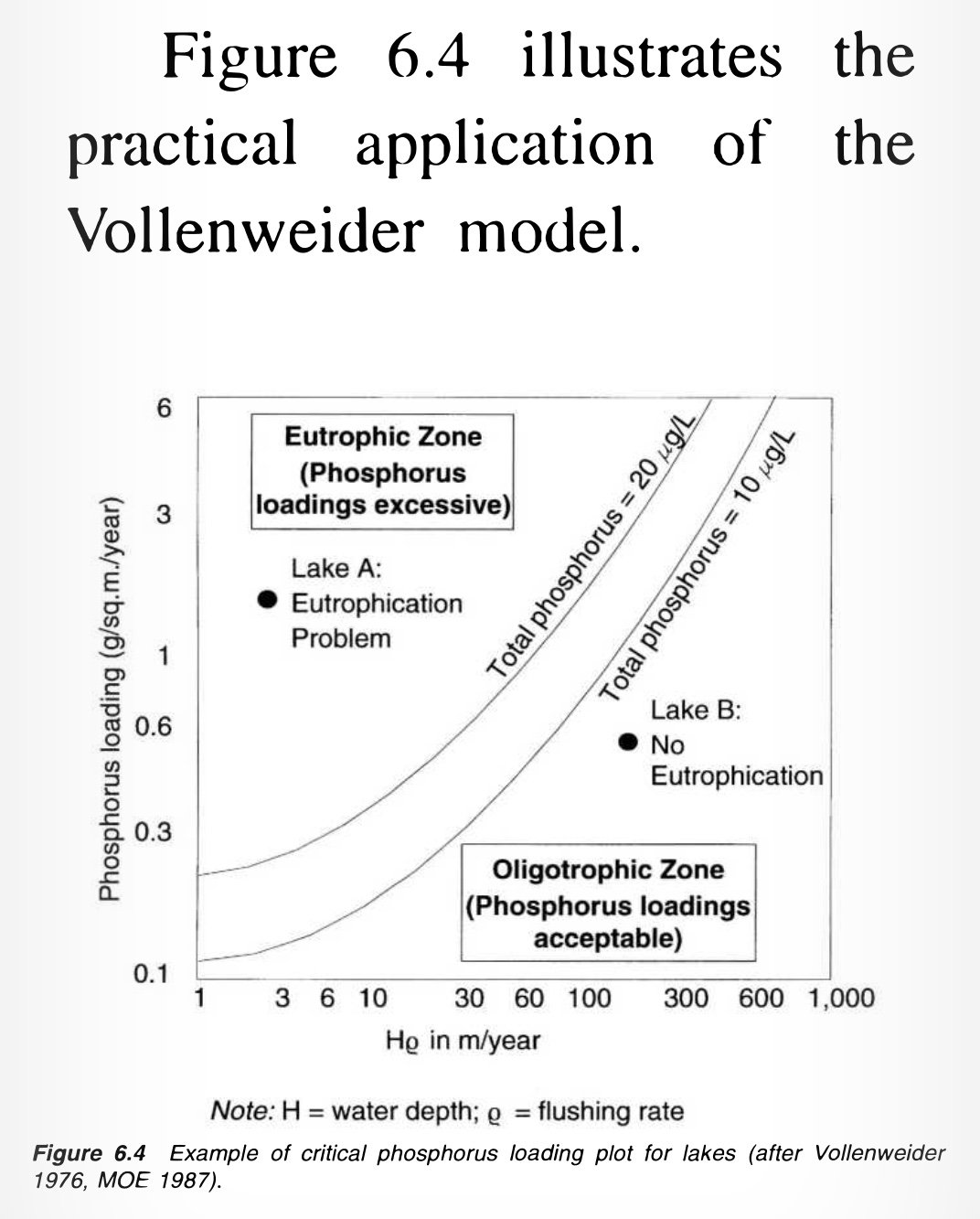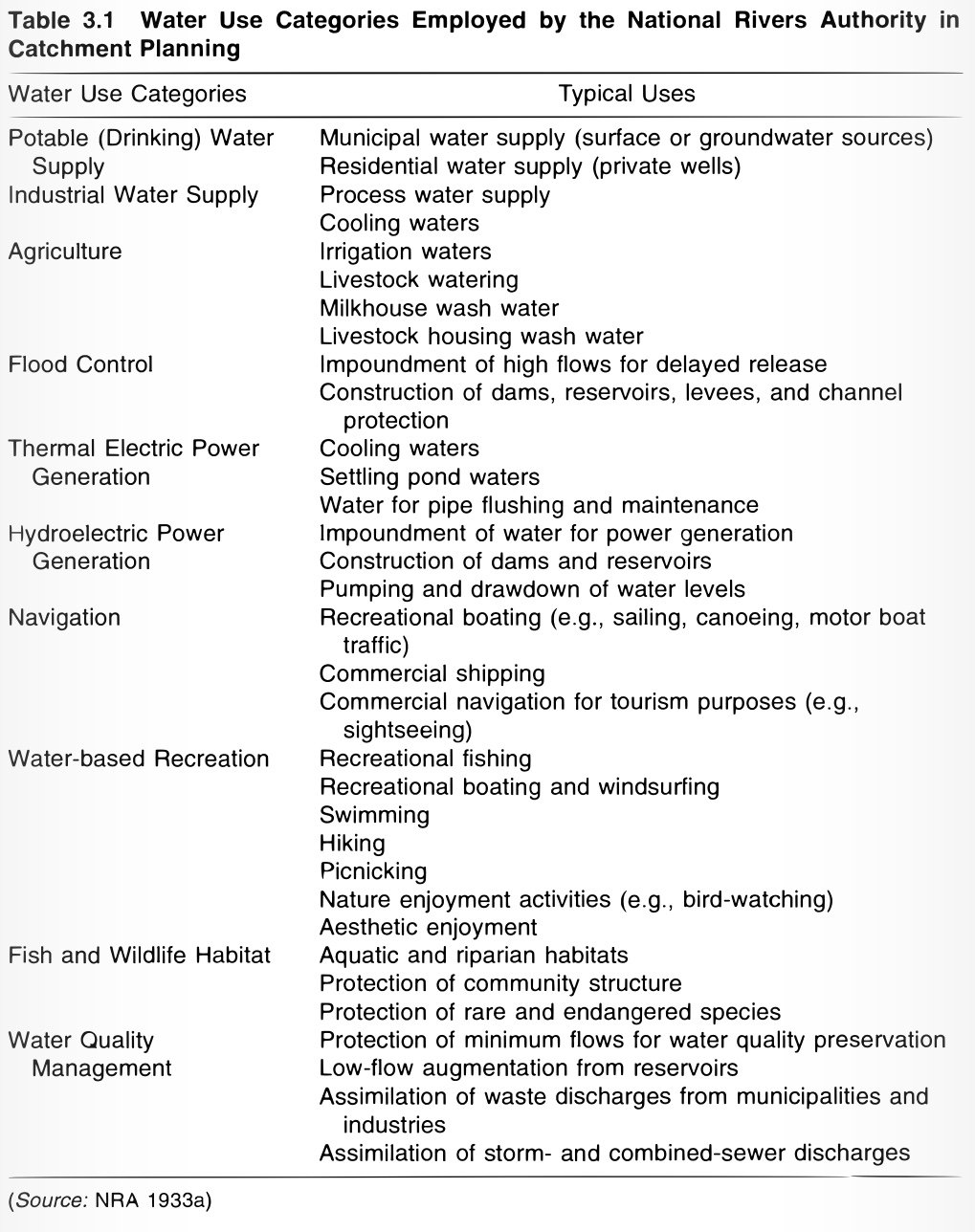Integrated Watershed Management by Heathcote
Ref: Isobel Heathcote (1998). Integrated Watershed Management, Principles and Practice. John Wiley & Sons Publishing. ISBN: 0-471-18338-5.
______________________________________________________________________
Summary
This book is concerned with developing an understanding of watershed components and processes, developing societal consensus as to the ideal condition of those watershed elements, and developing a plan to move the watershed toward a desired condition.
The watershed is the most appropriate unit for water management.
Overcentralization of water management, like overcentralization of social and economic systems, has failed and must be replaced with locally responsible systems at the watershed level.
Effective Watershed Management
Provides an adequate and sustainable supply of water.
Maintains water quality at levels that meet government and social standards.
Allows sustainable economic development over the short and long term.
Integrated Watershed Management (IWM) & Planning: Developing a social consensus about best choices with two principal goals:
Programs and projects that are economically efficient and socially desirable.
Projects that will be sustainable over a long period of time.
Fundamental propositions of IWM:
Common water resources are to be shared equitably between the states entitled to use them.
States are responsible for substantial transboundary injury originating in their respective territories.
Successful IWM
Adequate expertise for multiple-objective planning and evaluation procedures (economic, social, environmental).
Adequate resources of time and money for planning and implementation.
Consideration of a wide range of alternatives to solve observed problems.
A flexible, adaptable plan reviewed and amended at regular intervals.
Representation of all parties affected by the plan and its implementation.
Sufficient authority to enforce conformity of execution with construction and operating plans
______________________________________________________________________
Common Watershed Issues
Acidification: Impairs the survival of fish eggs and young fish, reduces aquatic species diversity, and may increase the need for drinking water treatment. Acidification results from the deposition of acid precipitation (caused by burning of fossil fuels) on acid sensitive soils and ‘soft’ (low-hardness) waters.
Restoration: Restrict emissions of acid-causing gases, add lime (CaCO3) to raise pH in natural waters, afforest with species other than conifers.
Impaired Fisheries: Decreases species richness through increased P; results from low dissolved O, potentially due to industrial and/or agricultural activities.
Blue-Green Algae (lakes and ponds): Algae blooms create water quality problems by using large quantities of O at night, through respiration, and through the O-demanding decay of dead plant tissue. Likely due to enrichment of waters with nutrients, especially P and N, which may enter water through a variety of human activities in the form of sewage discharge, agricultural runoff, and industrial effluents.
Decreased Summer Water Flow
Restoration: Storage of more water in reservoirs through the winter months so more is available for release in the summer. Farmers can construct on-farm reservoirs or grow less water dependent crops.
Wildlife Protection
Protection: Careful approval of abstraction licenses, land drainage permits, discharge permits, and land use planning applications. River-edge vegetation should be protected where sheep and cattle trample banks as they enter the river to drink.
Surface Reaeration: Occurs when the dissolved oxygen concentration of water is below saturation and oxygen from the atmosphere enters the water surface. This flux is proportional to the oxygen deficit and can be calculated as: rR=kR A (C,-C)= kR H (CS- C)=K2(Cs-C)
rR = rate of oxygen gain due to reaeration per unit time per unit volume of water, kR = reaeration flux rate (distance per unit time), A = free surface area of the control volume, V = control volume, Cs = saturation concentration of dissolved O, C = dissolved O concentration H = depth of control volume, K2 = surface reaeration rate (1/time). Although kR is more closely linked to the physics of oxygen transfer, K, is used more frequently.
Sediment Oxygen Demand: An important consideration in systems with high loadings of organic matter that may settle out and decay. For a control volume above bottom sediments, the sediment O demand can be calculated by: ks rs = H
rs - rate of O consumption due to sediment oxygen demand (mass per unit time per unit volume), ks - sediment O demand uptake rate (mass per unit area per unit time), H = depth of control volume response to the various aforementioned factors. Metcalf and Eddy (1991) suggest values for r,5 ranging from 2-10 gym' near municipal wastewater outfalls, to 0.05-0.1 g/m2 for mineral soils.
Bacterial die-off: Highly variable in natural waters and affected by a wide range of factors including temperature, salinity, incident light, available nutrients, and the growth characteristics of the species under consideration. The general equation for bacterial die-off is first order: r11 = -KI,CR
r11 - bacterial die-off rate (number of bacteria per unit time per unit volume) K1 = die-off constant (I/time) CB = bacterial density (number per unit volume) The die-off constant, KI, is determined empirically and is used to capture species-specific.
Fish Kills: Agricultural Activity- Increased Runoff- Heavy Loading of Sediments and Nutrients (Nutrient Enrichment)- Excessive Aquatic Plant Growth (Eutrophication)- nighttime O2 depletion- fish kills.
Internal (in-stream) sources: Chemical, physical, or biological sources internal to the watercourse, such as sediment resuspension (which can elevate suspended solids concentrations) or decaying biomass (which can affect the levels of nutrients, solids, oxygen-demanding materials, and other water quality constituents).
______________________________________________________________________
IWM Assessment Methods
Watershed Inventory: Develop an understanding of the many physical, chemical, and biological features and processes that affect water movement in a system. A watershed inventory serves two purposes:
To determine the nature and extent of use impairments in the basin.
To identify the causes of existing use impairments.
Problem Definition: Quantify and qualify water requirements and identify and rank problems to be solved, or beneficial uses to be restored.
Develop Management Options: Develop several good management strategies for the consideration of decision makers. Set clear & specific goals and develop weighted planning constraints & decision criteria.
Compare management alternatives
Choose the Best Plan
Implement the Plan: Develop clear and comprehensive implementation procedures for the plan intended to improve the state of the watershed ecosystem.
Simple Assessment Method: Focused assessment of a small number of use impairments.
Evaluate the current condition of the watershed ecosystem.
Identify the physical, chemical, and biological mechanisms that influence water quality and flow in the watershed.
Assess the quality and quantity of available data on watershed components.
Preliminarily select a methodology for evaluating the performance of alternative management strategies.
Compare data requirements of the methodology with available data.
Develop a field program to collect new data or supplement missing or outdated data.
Evaluate resource requirements of the proposed field program.
Adequate resources available: Execute the program followed by scenario testing.
Adequate resources unavailable: Reevaluate the proposed scenario testing methodology (or select a new one), with a view to simplifying the representation of the watershed system in space or time, to reduce required input data.
Develop and evaluate a revised field program.
Analyze until an acceptable balance of resource expenditure and management information has been reached.
Detailed Assessment: Analysis of complex systems to identify and characterize specific sources, quantify different management alternatives, elucidate processes such as cause-and-effect within the basin, detail the impact of specific remedial measures, obtain data on hydrology, water quality, and rates of physical, chemical, and biological processes, Detailed assessments are useful when one of the following conditions is present:
Pollutant sources are highly variable in quantity and quality.
The dynamics of the receiving water are complex (i.e., large river or lake).
Available data is inadequate to characterize sources or predict the impacts of management measures on the receiving environment.
There is a need to optimize the behavior of a complex system (i.e., a storm, sewer system, treatment plant).
NRA Approach
Identify catchment uses.
Set water use and water quality targets.
Determine the current "state of the catchment.”
Identify specific issues and management options.Develop a process for public consultation.
______________________________________________________________________
Watershed Inventory
Physical Features: Bedrock Geology, Surficial Geology, Landforms.
Climate: Temperature, Precipitation, Wind, Evaporation, Transpiration.
Evaporation
Daltons Law for Evaporation from free-water surfaces: E = C (es-ed)
E= evaporation rate (mm/day), C= a constant, es= saturated vapor pressure at the temperature of the water surface (mm Hg), ed= the actual vapor pressure of the air (es * RH) in mm Hg.
C= (.44 + .073W)*(1.465-.00073p), W= average wind velocity (km/hr) at height of .15m, p = atmospheric pressure (mm Hg) at 0 Celsius.
Reservoirs: use .77E.
Shallow Ponds: C= 15 + .93W (W= avg wind velocity in km/hr at height of 7.6m).
Small Lakes/Reservoirs: C= 11 + .68W.
Transpiration: Transfer of water molecules into the air through the tissues of living plants. Sometimes expressed as a ratio of the weight of water transpired to the weight of dry plant tissue.
Soils, Infiltration, and Runoff
Soils are classified on their permeability, infiltration rate, and surface runoff potential.
Permeability: Rate of water movement through a saturated soil; defined by Darcy’s law, Q = KhA/L
Q= flow rate (vol/time), K= hydraulic conductivity of the flow medium (distance/time), h= head or potential causing flow (distance), A= cross-sectional area of flow (area), L= length of the flow path (distance).
Infiltration Rate: Rate of water transport through an unmatured soil, defined by Horton, f= fc + (f0 – fc) e-kt
f= infiltration capacity (max rate at which a soil can take water through its surface (length/time), fc= the constant infiltration capacity as t approaches infinity, f0 = infiltration capacity at time of onset of infiltration, k= a positive constant for a given soil and initial condition, t= time.
Runoff
Runoff rates can be calculated in several ways: q= .002CiA
q= design peak runoff rate, C= runoff coefficient (dimensionless ratio of peak runoff rate to rainfall intensity), i= rainfall intensity, A= watershed area (hA).
In the SCS method, peak runoff rate (top of hydrograph), is q= quAQ.
q= peak runoff rate (m3/s), qu= unit peak flow rate (m3/sec per ha/mm of rainfall), A= watershed area (hA), Q= runoff depth (mm).
Streamflow (q): The rate of water flow expressed in units of volume per time.
q= (a(n.2 + n.8))/2, q= flow through segment of stream (vol/time), a= area of segment= measured depth * width, expressed as area, n.2= measured velocity at 20% of total depth, n.8= measured velocity at 80% total depth.
Total flow through the full cross section is then calculated as the sum of all individual segment flows: Q= q1+ q2+ q3 + qn
Groundwater
Aquifer: Saturated permeable geologic underground stratum that can transmit water.
Aquitard: A less permeable layer that may be significant to the regional transport of water but which has a permeability insufficient to permit economic development.
Zone of Influence: Distance between the well and the point where no significant influence on water level is observed.
Drawdown: Zone of lowered water.
Darcy’s Law: Describes the 1D flow of water in a saturated zone or aquifer.
Water Quality: Clarity, Conductivity, Hardness, Temperature, Aesthetics.
Clarity: Impacted by Suspended Sediments.
Suspended Sediment: Eroded particulates, silts and clay, organic detritus, and plankton. Waters high in suspended sediments have a turbid or muddy appearance.
Conductivity: Measure of electrical conductance of water.
Hardness: Dissolution of Ca and Mg minerals.
Chemical Indicators: Dissolved O, Nutrients, Heavy Metals, Organic Compounds.
Dissolved Oxygen: High levels of dissolved O are not usually of concern, but low levels, highly variable levels, or a complete absence of O can create conditions that are inhospitable for aquatic life.
Nutrients
The three pollutants most commonly described as nutrients are P, N, and silica.
N: Found in proteins and in the decay products of protein, such as Ammonia (NH3) and urea.
Freshwater Systems: N is abundant, and P that is the limiting nutrient.
Marine Systems: P is abundant, and N is the limiting nutrient.
Heavy Metals: Impair enzyme functions.
Biological Indicators: Bacteria, Virus, Parasites.
Plant and Animal Communities: Determine number, type, and quantity of plant and animal species.
Land Use: Divided into categories such as open space (rural, non-agricultural, undeveloped land), forested/woodlot, parkland, agriculture (rangeland and cropland), residential, commercial, industrial.
Social and Economic Systems
Pollutants: Analyzed by Loading and Concentration:
Loading: Total mass of a substance in a watercourse.
Concentration: The mass per volume of a substance in water; the most critical consideration in assessing potential impact on an aquatic system.
Watercourse Pollutant Sources:
Dry-Weather Point Sources: Discharges that occur continuously and that enter the watercourse from a single, distinct point, usually a pipe or diffuser.
Dry-Weather Diffuse (non-point Sources):
Wet-Weather Point Sources: Urban discharges of stormwater runoff and combined sewer overflows from a collection/distribution system outflow point.
Wet-Weather Diffuse (nonpoint) Sources: Diffuse drainage of rainwater from urban or agricultural lands.
Identifying Watercourse Pollutants:
List the land uses in the watershed, ranking them in order of land area.
For each land use, estimate the proportion of land surface that is permeable (e.g., cropland, park land, forests, and woodlots) versus impermeable (e.g., roads, parking lots, roofing).
From available sewer maps, determine which areas of the basin are drained by storm and sanitary sewers, and the location of discharge points for each system.
Identify the known dry-weather (continuous) point sources to the system.
Identify the known wet-weather (intermittent) point sources to the system, including stormwater discharge points and combined sewer overflows.
Estimate pollutant-generation potential of land uses that have a high proportion of pervious surfaces
Estimate potential for internal sources or processes to generate or remove flow or pollutants to/from the system.
Pollutant loads from areas with predominantly pervious surfaces (most rural areas and urban open space) are easily estimated with the Universal Soil Loss Equation (USLE).
If there are several sources of a single pollutant; determine which is the most important contributor to the total load and which would repay the greatest benefit per dollar spent on remediation.
Rainfall
Urban Areas: Most rainwater falls on paved or roofed surfaces and is diverted through sewer systems and to treatment or discharge points.
Rural Areas: Most rainwater infiltrates into soils, is taken up by growing vegetation, or is returned to subsurface flows.
Average Annual Soil Loss: A= RK(LS)CP
A = average annual soil loss (mg/ha), R = rainfall and runoff erosivity index for location of interest, K = soil erodibility factor, L = slope length factor, S = slope steepness factor, C = cover management factor, P = conservation practice factor.
Stormflow Pollutant Quantity: Estimated as a fraction of curb storage; W = CD ) Sr,
W = washed-off pollutant load in the sewer or at the basin outlet (kg per storm event), S = stored curb load of the pollutant during the preceding dry period (gym curb length), CD curb density (km/hA), A = subwatershed area (hA), r = wash-off factor (related to runoff energy).
Following pollutant source analysis, apply any planning constraints and eliminate any options that are clearly inappropriate or impractical for the planning situation. The remaining "short list" of options can then be subjected to screening.
Construct a Watershed Foundation Map
Watershed Foundation Map: Used to assist in developing management options; highlights the watershed inventory; shows topography, major features, areas of cultural/spiritual importance, species habitats, land use, pollution discharge areas, political boundaries, key water uses, recreational areas, etc.
______________________________________________________________________
2. Problem Definition
Evaluating urgent problems in a Watershed
List existing (or perceived) use impairments and their causes.
Compare existing receiving water or sediment quality with published national or state/provincial targets.
Interview key informant and media reports.
Evaluation: What is the disparity between existing and ideal conditions?
Estimation: What is the water demand required based on estimation of population size and potential growth.
Water Demand: Expressed as water withdrawal and consumptive demand; influenced by population size and density, annual per capita income, quality of supply, and annual rainfall.
Water Withdrawal: The total amount of water removed from natural systems for human use, and
Consumptive Demand: The volume of water removed by humans but which is "consumed" in the removal and thus unavailable for return to natural systems.
The product of' the planning exercise is not a set of "facts," but rather a community consensus as to the desired plan of action and its probable effectiveness.
Watershed Critical Planning Assumptions
Estimated population growth rate.
Estimated precipitation.
Estimated volume of surface and/or groundwater available for future extraction.
Nature of water-using industries, commercial establishments, and institutions in the basin.
Time Horizon: Set targets not only for current uses but also the mid and long term:
Immediate: 1-2 y post project.
Short-term: 3-5 y post project.
Long-term: 10-50 y post project.
Target setting for water quantity:
What proportion of annual flows is required to meet withdrawal and service non-withdrawal uses?
What proportion of estimated withdrawals is consumed (not returned to the hydrologic system for reuse)?
How are these supply-to-demand ratios likely to change in the future in response to population growth, consumption rates (per capita income and conservation policies), or climate change?
Factor in rare or endangered species and/or habitats, valued historical or archeological remains, Areas of great natural beauty, Habitats especially susceptible to disturbance, such as wetlands or flood plains, Designated park lands, Nature reserves, Scientific research stations.
Scoping: Determination of which uses and watershed areas do and do not require management interventions. Scoping has two important components: boundary setting and focusing.
Boundary Setting: The limitation of a plan to a specified geographic area, a particular time period, and a small number of species or populations of interest.
Focusing: Identification of issues that have overriding importance in the basin.
Adaptive Environmental Assessment and Management (AEAM): An approach used to develop consensus in scoping. AEAM is both a philosophical and a methodological framework aimed at using existing knowledge of an environmental system to develop sound management approaches for it .
Three questions central to scoping:
Which uses are currently impaired?
Which are most important to the community?
For each impairment, what are the best indicator parameters of a healthy condition? What specific (even numerical) targets should be met, to consider the impaired use as having been restored?
Source Evaluation
Explicit identification of the issue to be resolved, usually expressed as a use impairment.
Explicit identification of the target(s) to be met (i.e., the point at which the problem will be considered "solved" or the use restored).
Explicit identification of measures of progress toward desired targets, sometimes termed "indicator variables."
An inventory of all sources within the basin that affect the levels of these indicator variables.
Description of the behavior of these sources in space and time.
Ranking of these sources in terms of their overall contribution to the problem (usually expressed as total mass, for pollutants, or volume, for flows, contributed or as a percentage of the total mass or volume).
Elimination of trivial sources (usually those contributing less than 5% of the total load) from further consideration.
______________________________________________________________________
3. Develop Management Options
IWM Options: For each nontrivial source (>~5%), identify management option(s) and assign weighting:
Do Nothing: Retaining the status quo.
Structural Measures: Built technologies or structures
Vegetative Measures: Practices that alter the vegetative cover of the land, almost exclusively used in the control of non-point sources of pollution.
Non-structural options: Best Management practices.
Evaluation Criteria Must Be:
Able to capture the vision of the community in terms of a desired future condition.
Useful in separating alternatives (criterion where all options score equally is of little use as a screening tool).
Explicit and specific; measurable in some objective way.
Constraints: The practical limitations to a solution (the limits beyond which a manager may not go); the first step in option screening. Constraints must be: exhaustive, inclusive of all factors that may place practical limits on the planning exercise, specific and quantitative; if possible, expressed as numerical limits so as to permit a "pass-fail" evaluation, and endorsed by the decision-making group and by the wider community. IWM Constraints:
Environmental quality must be maintained or improved.
Economic activities should not disturb natures regenerative capacity, the assimilative capacity, or the productivity of life-support systems.
No resources should be wasted.
Incentivize environmental improvement and plans/programs that encourage political and economic stability.
Maintain future options (the central challenge of sustainability); each future generation will have the same capacity and option to solve its own problems as currently exists.
Preference to institutional arrangements that encourage ecological, social, and economic diversity, which are more capable of responding quickly, positively, and flexibly to change.
Controlled population growth, so that future generations will have equivalent opportunities for solving their own problems and will have equal access to resources.
Controls on pricing, harvesting, and regeneration rates to conserve and enhance the value of natural capital.
Depletion of Nonrenewable resources at a rate that maintains the aggregate value of renewable and nonrenewable resources.
Redistribution of wealth to poorer countries to enable them to manage their resources sustainably.
Comparison/Screening Programs: Determines feasibility (meets the constraints imposed by cost, space, time, technology) of alternatives and identifies which performs best in terms of specified evaluation criteria.
Compensatory Analysis: Reduction of all considerations to dollar values.
Lexicography: A stepwise process of option screening that requires weighted attributes, for which the most important is then used to choose the "best" option.
A long list of options is identified, feasible options are chosen from that list (probably on the basis of cost and rough estimates of pollutant removal), and one or more preferred options are identified for further action.
Source Flow-Transformation Assessment
Determine sources transported within watershed:
Determine method of transport within watershed (Advection, Diffusion, Volatilization, Deposition):
Advection: Transport of material by the flow of water into or out of a control volume.
Diffusion: Transport by turbulence in the water; caused by small velocity variations acting in conjunction with concentration gradients.
Determine material transformation in the watershed (Sedimentation, Resuspension, Adsorption, Die-Off).
Determine which mechanism has a significant effect on material transformation (v. What is trivial?).
Determine the time scale at which important mechanisms operate.
Determine the Spatial Scale at which important mechanisms operate.
What equations help to predict system response within altered management scenarios?
What factors affect the rate at which these processes occur?
Use of modeling and data to substantiate these processes: stream hydrographs, patterns of species diversity, annual cycling of algal populations, fish spawning patterns and timing, etc.)
Determine Sampling frequency and the spatial distribution appropriate for data collection.
______________________________________________________________________
4. Compare Management Alternatives
Eliminate options that are not feasible because of time, cost, space, or other constraints.
Test the effectiveness of remaining options using the methods identified and weighted decision criteria.
Determine economic impacts and legal implications of the various options and their environmental impacts.
Analysis Methods
Benefit-Costs Ratio Analysis: A project is considered economically viable if benefits outweigh costs (B/C > 1).
Separable Cost-Remaining Benefits (SCRB) Method: Allocates costs on the basis of "purposes"-that is, intended impacts of the project (e.g., irrigation, power generation, flood control, etc.).
Travel-Cost Method: Evaluates how much an individual on average will spend to visit a particular resource.
Economic Comparison: Reduce all options to a common basis of comparison, which can be present value, future value, or payment amount (annual value).
Internal Rate of Return: Comparison on the basis of their rate of growth over a planning period.
Future Worth (Future Value) Method: Comparison of alternatives on the basis of their future value.
Comparison Steps
Rank the options in order of increasing (capital) costs.
Take the lowest-cost alternative as the base case, or current "best" alternative. Evaluate the present, future, or annual worth of this option, or its IRR.
Determine whether the performance of this base option on the chosen measure is adequate, or whether the money would be better left in the bank. The option is viable economically if its present (or future or annual) worth is positive or if its IRR exceeds some predetermined target, such as the prevailing bank interest rate.
Identify the next most expensive option. Calculate the performance of the incremental cash flows for this option using the same measure applied in (2) for the base case- subtract the costs of the base case from the costs of the next most expensive option, and conduct the analysis only on these incremental costs.
Determine whether the expenditure of additional funds to achieve the second option is warranted. In other words, determine whether the present (or future or annual) worth of the incremental cash flows is positive or the IRR of the incremental cash flows exceeds some predetermined target (i.e. bank interest rates).
If the expenditure of the incremental funds is deemed to be viable, the second alternative becomes the "current best" alternative. If the expenditure of incremental funds is not deemed to be viable, the original, base option remains the "current best" and the second alternative is discarded.
Repeat steps 4 through 6 until all alternatives have been examined.
Select as the preferred alternative the last one for which the incremental cash flow analysis was favorable.
Inconsistent Ranking Problem: When an alternative is ranked as "best" using one method, but second or third using another method.
Common Comparison Metrics
Conventional Benefit-Cost (B/C) Ratio: Ratio of equivalent worth of benefits to equivalent worth of costs. The general approach in benefit-cost analysis is to maximize the B/C ratio.
Maximize total benefits: Choose the alternative that has the highest present worth of total benefits.
Maximize net benefits: Choose the alternative that has the highest net benefits (total benefits - total costs).
Minimize total costs: Choose the lowest-cost alternative that still demonstrates a B/C ratio > 1.0.
Minimize capital (investment) costs: Choose the alternative that has the lowest initial costs, but which still demonstrates a B/C ratio > 1.0.
Minimize operating and maintenance costs: Choose the alternative that has the lowest operation and maintenance costs, but which still demonstrates a B/C ratio > 1.0.
Maximize rate of return.
Incorporating Risk
Temporal Risks: The further into the future an event will happen, the less precise our estimates about it will be; interest rates, utility rates, capital investment requirements, market share, inflation rates, taxation rates.
Decision Making Under Risk: Possible outcomes are known, and their respective probabilities are known.
Decision Making Under Certainty: Possible outcomes may be known but their probabilities of occurrence are not known.
Risk Aggregation: Basic approach to incorporating risk.
______________________________________________________________________
5. Choose the Best Plan
It is better to have a less effective plan that is fully implemented than a highly effective plan that remains a paper exercise.
What is 'reasonable and equitable" is to be determined in light of all the relevant factors including basin geography, basin hydrology, climate, past and present water uses, economic and social needs of water users, the population dependent on the waters of the basin, the comparative costs of alternative means of satisfying the social and economic needs of each water user, the availability ability of other resources, the avoidance of unnecessary waste in water use, the practicability of compensation as a means of adjusting conflicts between users, and the degree to which the needs of one state (user) may be satisfied without out causing substantial injury to a co-basin state (user).
______________________________________________________________________
6. Implement the Plan
______________________________________________________________________
How IWM Projects Fails
Inability to match projects to watershed conditions.
Too ambitious to be achieved with available financial and other resources.
No or limited enforcement mechanisms.
Do not meet the expressed goals of the plan.
Fail to guide development properly.
Underestimate or ignore environmental impacts of the plan or individual projects.
Underestimate or ignore social impacts, such as disruption of community cohesion, displacement of groups or individuals, or loss of key social structures that provide a focus for community activities.
Overestimate the efficiency or availability of existing institutional frameworks to support implementation, or fail to create an organization with adequate staffing and responsibilities to ensure that projects are sustained beyond construction and early operation stages.
Lack good leadership and/or adequate staff training.
Disregard or underestimate the legal implications of the plan.
Lack an adequate infrastructure of facilities and services such as roads, marketing organizations, and other components.
Fail to recognize national, regional, local, and individual costs and benefits of the project in formulating and analyzing management options and selecting priorities for action.
______________________________________________________________________
The Consultation Process
Meaningful inclusion of the public through the plan-testing process can reassure all participants about the costs and benefits of each strategy under consideration.
Comprehensive Public Info Program: Ensures that people making decisions do so in command of all the facts.
Ensure public involvement by appointing public representatives on advisory committees.
Conflict Resolution (aka alternative dispute resolution- ADR): Seeks the common ground in a dispute. The conflict resolution process is focused on learning each party's true interest and likely fallback position and developing innovative solutions that accommodate the true interests of the various parties.
Sources of Silence (of potential participants):
Adequate feeling of representation by some other group, such as a neighborhood association or environmental public interest group.
Unaware they have a stake in the decision or view the decision as of minor importance.
Do not believe that they can influence the outcome of the process.
______________________________________________________________________
Modeling & Sampling
Modeling: Predictions should always be shown with some estimate of error or uncertainty.
Model Verification: Determining whether the algorithms used by the model are appropriate for the system or should be replaced with others more suitable
Model Calibration: Model tuning to simulate a set of observed conditions with a high degree of accuracy.
Model Validation: See how well the tuned model predicts a different data set, without changing any input variables or rate kinetics.
Sensitivity Analysis: Determine which input variables are most sensitive (influence model output) to changes.
Validation: Testing a model on different data sets to ascertain the probable predictive error in the model and thus, its probable reliability in simulating future conditions with and without management intervention.
Sampling
The central problem of any sampling program, whether or not related to water, is to obtain a reasonably accurate picture of a complex system from a small set of observations.
A single sample is never enough to characterize a time-variable stream. At minimum, a sampling program should include at least three samples, representing low, mid-range or typical, and high conditions.
______________________________________________________________________
Costing and Financing
Public Work Costing: Includes design, building, maintenance, operation, and retirement. All costs must be factored into the price charged the customer, or the utility will end up subsidizing costs to some degree. Current thinking suggests that rates should also include provisions for sinking funds to cover future maintenance and replacement costs.
Book Cost: The estimated cost of an asset, including any depreciation.
Capital Costs: The labor and materials costs required to build or implement water management measures.
Cash Costs: Those that are used in calculations of future expenditures.
Direct Costs: Costs that can be measured and are attributable to a particular product or work activity
Disbenefits: Impacts on the environment.
Fixed Costs: Expenses paid independent of any specific activity.
Incremental Costs: Additional Costs.
Indirect Costs (aka Overhead): Costs that are shared and thus difficult to attribute, i.e. the cost of tools, general supplies, equipment maintenance, heating and lighting, etc.
Life Cycle Costs: Costs incurred over the entire life of a project,
Nonrecurring Costs: ‘Extraordinary’ not-expected expenses.
Opportunity Cost: The cost of losing an opportunity to use the money elsewhere.
Recurring Costs: Repetitive Costs.
Sunk Cost: A cost that is behind you, that no longer figures in current planning or analysis.
Variable Costs: An expense that changes in proportion to how much is produced or sold.
Sources of capital
Debt capital: Borrowed Money.
Bond Sales: The Most common type of debt financing in major public projects.
Equity Capital: Available Money.
Costing Major Public Works
Drinking Water Supplies: Drilling, Well Maintenance, Extraction Systems, treatment and disinfection, labor and materials, construction and maintenance of buildings, workers, equipment, supplies, construction and maintenance of distribution, &c.
______________________________________________________________________
Legal, Institutional, and Administrative Concerns
Societies rules and legal system reflect a sort of social consensus as to what that society currently judges to be morally correct and just.
Laws: Made in the courts through the decisions of judges, based on legal precedents. Laws need not be written to have force: only that a court upholds long-standing traditions of property rights and personal justice.
Administrative Law: Legal powers granted to admin agencies by the legislature and rules that the agencies make to carry out their powers; includes court rulings in cases between agencies and private citizens.
Common Law (aka Private Law): The unwritten Law of Individuals seeking compensation (‘damages’) and/or an injunction (temporary or permanent) to stop a defendant from continuing an offensive action. It is a long-held tradition that an injunction will never be granted if damages can give an adequate remedy in the case.
Statutes (written laws): Aspects of common law that have been extracted and written down; approved by elected governments and enforced by public agencies. Two types of statues: Criminal Laws (theft, murder, rape) and Public Welfare Laws that address matters regulating acceptable conduct.
Cause of Action: The right to sue an individual or group to bring a complaint (suit) before a judge and ask for compensation or an injunction to stop an offense. The most common in terms of water and environmental management are nuisance, riparian rights, strict liability, trespass, and negligence.
Statue Law (aka Public Law): The Law of Major public bodies acting on behalf of the people; fines are paid to the government, not to individuals. Statutes can require the cessation of an offensive activity.
Legal Definitions
Intrusion: Must be intentional and negligent.
Liability: Deemed to exist if the activities of the defendant have caused real harm to another’s health or property.
Offense: Must prove the defendant could have foreseen the consequences of his or her action but did not take steps to prevent the nuisance from occurring.
Strict Liability: The owner of dangerous goods or materials is responsible for seeing that those goods or materials do not cause harm to neighboring people or properties.
Negligence: Conduct that falls below the standard regarded as normal or reasonable in a given community.
Nuisance: The societal precept that one person should not interfere with another's peaceful enjoyment of property including air, water, noise, vibration, and smell pollution, and soil contamination, flooding, and similar intrusions into peaceful enjoyment of property. Measured by the degree of impact on "peaceful enjoyment."
Defense:
Statutory Authority: The law required that the defendant take the action that caused the effect; the effect was therefore unavoidable.
Prescription: The activity had been conducted for a long time in the same place without complaint and should be allowed to continue.
Acquiescence: The plaintiff knew of the situation and failed to make a complaint within a reasonable period of time.
The “best available technology” was used to avoid the effect, but the effect occurred anyways; the activity existed before the plaintiff arrived on the scene.
Offense: Harm must be proved to have occurred.
Trespass: individuals should not enter others' property, nor should they deposit materials there, without the express permission of the property owner or tenant.
Defense: Must prove that entry was unintentional.
Offense: Landowners must show that no trespassing signs were posted regularly and that real and direct harm resulted from intrusion.
Bills into Laws
US Congress (USC): "Make all laws which shall be necessary and proper.” Powers include the "power of the purse" (taxation and spending), the power to coin money, regulate trade, and wage war. USC approves POTUS choices for senior govt appointments and Supreme Court Justices and approves/rejects international treaties.
Congressional Committees (Senate- 16, House- 22): Either "report" (pass on) or "table" (shelve) bills. If reported, bills pass to the Rules committee for calendaring (scheduling for formal debate on the floor). The Senate has one calendar for public/private bills, the House has five; for bills that raise or spend money, other public bills, private bills, noncontroversial bills, and for motions to remove a bill from committee.
Rules Committee: Decides which bills will be debated on the floor and conditions that apply to the debate.
POTUS has 10 days (excluding Sun) to sign/veto a bill, otherwise the bill becomes a Law (as long as USC is in session).
______________________________________________________________________
Environmental Acts
Environmental Protection Agency (EPA): Administers the Clean Air Act, the Clean Water Act, the Safe Drinking Water Act, the Ocean Dumping Act, the Pollution Prevention Act, TSCA, FIFRA. CERCLA, and RCRA.
Boundary Waters Treaty (1909): Establishes guidelines for reducing point and nonpoint sources of pollution into binational (USA & Canada) channels including the boundary waters and the St. Croix.
Federal Water Pollution Control Act (aka the Clean Water Act or CWA): Aims to improve water quality for the "protection and propagation of fish, shellfish, and wildlife" and for "recreation in and on the water.” Controls point- source pollution and includes seven provisions for the control of water pollution:
National Pollution Discharge Elimination System (NPDES or permit system): Requires point-source dischargers of wastewaters hold valid discharge permits.
Control and prevention of accidental or intentional spills of oils and toxic substances.
Regulates dredging and fill materials and activities.
Publicly Owned Treatment Works (POTW): Provides grants & subsidy programs for sewage treatment plants.
Requires states to establish a planning process for point and non-point point sources of pollution.
State regulation of land use practices in order to pursue national water quality objectives.
Provides a framework for the states concerning the structure of nonpoint-source management programs.
Great Lakes Critical Programs Act (CPA): Amends Section 118 of the CWA; requires the US EPA to develop water guidance for the Great Lakes system, which establishes the Great Lakes Water Quality Guidance (aka Great Lakes Initiative, 16 Apr, 1993).
Clean Air Act (1970): Comprehensive federal law that regulates air emissions from stationary and mobile sources; authorizes the EPA to establish National Ambient Air Quality Standards (NAAQS) to protect public health and public welfare and to regulate emissions of hazardous air pollutants.
Coastal Zone Act Reauthorization Amendment (CZARA): Requires coastal states with approved coastal zone management programs to address nonpoint-source pollution sources that impact or threaten coastal waters.
Comprehensive Environmental Response, Compensation, and Liability Act (CERCLA or "Superfund'): Authorizes the US EPA to respond to environmental disasters.
Federal Insecticide, Fungicide, and Rodenticide Act (FIFRA): Authorizes the EPA to control pesticides that may threaten ground and surface waters. The Act suspends or cancels pesticides containing toxic chemicals including DDT, dieldrin, aldrin, chlordane, heptachlor, Hg, kepone, chlorobenzilate, endrin, DBCP, and 2,4,5-T silvex.
Food Security Act (FSA): Establishes greater consistency between farm production and soil and water conservation programs by providing more forceful obligations for soil and water conservation in the form of cross-compliance for those farmers dependent on government commodity and subsidy support programs.
International Rivers Improvement Act: Regulates the construction, operation, and maintenance of dams and diversions in international rivers.
Marine Protection, Research, and Sanctuaries Act (Ocean Dumping Act): Provides guidelines for the dumping of wastes and other materials into the oceans by designating certain sites as approved locations for ocean dumping and others as sanctuaries, to be patrolled by the USCG. The Act prohibits the disposal of CBRN agents into the oceans, restricts the ways in which US vessels can discharge wastes into the oceans, and prohibits unauthorized transportation from US territory with the purpose of ocean dumping.
National Environmental Policy Act (NEPA): Requires Environmental Impact Statements (EIS) by federal agencies before they undertake actions with potential to impact the environment.
Pollution Prevention Act: Requires that where possible, pollution should be prevented before it is created rather than managed after the fact; established national targets for recycling and establishing an Office of Pollution Prevention as an information clearing house.
Resource Conservation and Recovery Act (RCRA): Addresses solid waste disposal and requires states to (I) identify strategies to protect citizens against adverse effects of solid waste disposal; (2) describe how they will provide adequate sanitary landfill capacity, and (3) demonstrate adequate institutional arrangements for implementing these strategies.
Safe Drinking Water Act (SDWA): Establishes mandatory and nationwide drinking water standards; administered by state and local authorities. The SDWA was amended in 1986 to increase the EPA’s requirements for disinfection, filtration, containment monitoring, and GW protection.
Lead Contamination Act: Amends the SDWA to safeguard against contamination of drinking water with Pb.
Soil Conservation Act: Requires farmers with highly erodible lands to plan and apply soil conservation system in order to remain eligible for farm program benefits.
Toxic Substances Control Act (TSCA): Established several programs relating to the introduction of new and potentially hazardous substances into commerce and lays out requirements for premanufacture testing and notification; authorizes the EPA to require manufactures of certain chemicals to undertake extensive testing of those chemicals if there is a high risk of exposure.
Canadian Environmental Acts
Fisheries Act (Canada): Protects fish and other marine animals and their habitats in all internal and coastal waters.
Navigable Water Protection Act (Canada): Requires work affecting navigable waters to first be approved by the Ministry of Transport.
Pest Control Products Act (Canada): Administered by Agriculture Canada; the principal statute governing pesticides; prohibits any person from manufacturing, storing, displaying, distributing, or using any pest control product under unsafe conditions.
Wildlife Act (Canada): Administered by Environment Canada; Imposes controls on point- and nonpoint-source pollution in areas designated for the protection of wildlife.
Water Rights Allocation
Appropriation Rights (“First in Time, First in Right”): Appropriators are assigned rights based on their priority of application for those rights. A would- be water use must apply to the appropriate state agency, stating the beneficial use to which the water will be put. If successful, they are assigned a date that determines priority.
Correlative Rights: Grants landowners groundwater supplies proportional to the extent of land ownership.
Reasonable Use (Sensible, Conservative, Equal): Permits Landowners to modify water quality & flow as long as the use is deemed reasonable for the purpose to which the land was put. Found in places relatively rich in water.
Riparian (banks of a lake or stream): Permits landowners to use the water that flows through their property, unimpeded in quantity and unimpaired in quality.
______________________________________________________________________
Rivers
Danube River (Central Europe, L: 2850km)
Bordered by 10 EU countries supporting > 70M people.
>300 tributaries.
Intl Agreements: Danube Declaration (non-binding).
Rhine River (Central Europe, L: 1320km)
Catchment encompassing 9 EU countries supporting >50M people.
Heavily polluted with Hg, Arsenic, Cadmium, Pb, Cu, Z, Chromium, and Chlorides.
Intl Agreements: Treaty of Vienna (1815), Central Commission for the Navigation of the Rhine, International Commission for the Protection of the Rhine against Pollution.
______________________________________________________________________
Terminology
Appropriate Technology: Technology that is known and understood in the community and that has a high likelihood of continued success over many years.
Artist's mind-set: Used to combine existing ideas to come up with something new.
Average Plant Factor: Ratio of average output to rated capacity.
Blended (the Cost of Money): Interest + Inflation.
Block pricing: The more you use, the more you pay per unit used.
Break-Even Point: The point at which the revenue from a project equals its costs, the project should be profitable or it is not viable; Profit or loss = total revenue - total costs.
Custom of Paris: French Legal Code.
Decisional Leaders: Leaders with the ability and the interest to influence public opinion.
Demand Management: Legal, Paralegal, and nonlegal measures for water use including extraction permits/licenses, ambient water quality standards, effluent discharge standards, and fines/sanctions associated with noncompliance.
Deleterious Substance: Any substance that if added to water would degrade or alter or form part of a process of degradation or alteration of the quality of water so that it is rendered or is likely to be rendered deleterious to fish or fish habitat or to the use by man of fish that frequent that water.
Depreciation Funds: Funds set aside from profits as a source of capital to replace aging equipment.
Detective's mind-set: Used to define a problem to be solved.
Economic Instruments: Effluent charges, grants and subsidies for pollution abatement activities, taxes and regulations.
Environmental Assessment (EA): A systematic process of evaluating and documenting information on the potentials, capacities, and functions of natural systems and resources in order to facilitate sustainable development planning and decision making and to anticipate and manage the adverse effects and consequences of proposed undertakings.
Environmental Impact Assessment (EIA): A process of identifying, predicting, evaluating, and mitigating the biophysical, social, and other relevant effects of proposed projects and physical activities prior to the making of major decisions and commitments.
Environmental Nongovernment Organization (ENGO)
Explorer's mind-set: Used to place the problem in context.
Human Cost Accounting: Measuring the psychological and behavioral impacts of a project.
Lakewide Management Plans (LaMP):
Leopold Matrix: A visual summary of analyses that appear in narrative form.
Limiting Nutrient: The nutrient whose concentration determines whether additional biomass can or cannot be produced.
Magnitude: How big an effect will be; the difference between pre- and post-project conditions.
Mercury Poisoning: Inorganic Hg (relatively non-toxic to humans and other organisms) converts to methyl Hg in the water column, which bioaccumulates through the food web and persists in body tissues.
Methemoglobinemia: Disease, particularly troublesome in infants and older adults who tend to produce less gastric acid and have higher digestive pH levels. At higher pH levels, NO3 ions, common in food and drinking water, readily convert into NO2 ions, which react with hemoglobin to create in inactive methemoglobin form, reducing its O carrying capacity and causing O deficits in the affected individual.
Nonstructural Measures (aka Best Management Practices): Measures that rely on changes in human behavior or management practices.
Oligotrophic: Low in nutrient loadings and therefore not subject to nuisance algae blooms.
Precautionary Principle: Where there are threats of serious or irreversible damage, lack of full scientific certainty should not be used as a reason for postponing measures to prevent environmental degradation; the basis for sustainable development.
Predictive Error: The difference between observed and predicted values, gives an indication of how well a model will perform in simulating future scenarios.
Procedural Democracy: Building social consensus by Involving the public in major public activities.
Residual Impacts: Effects that are expected to remain after mitigative measures have been put in place.
Remedial Action Plans (RAP):
Retained Earnings: Profit made by a company and kept for reinvestment in future projects.
Significance: The importance of an effect to the community.
Social Impact Assessment (SIA): A process of estimating the social consequences that are likely to follow from specific policy and government proposals.
Social Profiling: Mapping the range and depth of public concerns in a systematic fashion.
Strategic Environmental Assessment (SEA): An appraisal of policies, plans, and programs with significant potential to affect water resources management; contains accountability and monitoring by initiating agencies, an assessment of biophysical, economic, and social effects in program design, the scope of potential impacts, a provision for public involvement and explicit inclusion of environmental factors in policy-making.
Structural Measures: Measures that use technology or structures to change existing conditions.
User/Polluter Pay Principle: A financial disincentive in which users of a pollutant are taxed or pay for its use.
Usury: Unacceptably high interest rates (prohibited in Exodus 22:25).
Voluntary Instruments: Nonbinding MOUs between a government and industry to reduce the volume or improve the quality of waste emissions, to avoid or eliminate the use of certain chemicals.
Water Quality: Measured using dissolved O, pH, bacteria count, temperature, hardness, toxic substances.
Water Quality Standards: Legally binding requirements.
Water Quality Targets: Criteria, or guidelines, intended to reflect an ideal condition.
Watershed: A drainage basin; an area of land within which all waters flow to a single river system.
______________________________________________________________________
Misc Quotes
Scientific conclusions applied to solving human problems, invariably incorporate a range of value judgements.
Many people today are addressing yesterday's goals or addressing today's problems with yesterday's practices.
In a democratic society, public decisions should reflect broad social values and changing policy should equally reflect changing values.
"For us bureaucrats, armed with advanced engineering and scientific degrees, this is a hard pill. To us, emotions are irrational; facts can be separated from values."
"All models are wrong. Some are useful. The trick is to know why, and how."-Bill James.
On average, Canadian water prices were about 65% of the real cost of providing water supply and sewerage. The difference was made up by government grants and subsidies that are invisible to the consumer but are often buried in the residential tax bill.-MISA Advisory Committee, 1991.
Resource consumption should entail "full-cost" pricing, eliminating grants and subsidies, and making the full cost of service transparent to the customer. Current thinking suggests that rates should also include provisions for sinking funds to cover future maintenance and replacement costs.-MISA Advisory Committee.
Pollution is viewed as the inevitable consequence of development, the price that must be paid if economic progress is to be achieved.
A hypothesis is something like "Current average river concentrations for parameter X exceed desired target values to test this hypothesis.”
______________________________________________________________________
Chronology
1995: The Canadian Environmental Assessment Act (CEAA) is passed establishing the Canadian Environmental Assessment Agency to screen, comprehensibly study, and review legislation.-IWM by Heathcote.
Jun, 1992: The Rio Summit; the UN’s Conference on Environment and Development; 156 nations sign a convention on biological diversity.-IWM by Heathcote.
1990: The Pollution Prevention Act is passed by the USG requiring that where possible, pollution should be prevented before it is created rather than managed after the fact. The act established national targets for recycling including an office of pollution prevention.-IWM by Heathcote.
1988: The Lead Contamination Act amends the SDWA to provide additional safeguards against contamination of drinking water with Pb.-IWM by Heathcote.
1988: The Canadian Environmental Protection Act (CEPA) is passed to reduce point and nonpoint source pollution.-IWM by Heathcote.
1985: The EU establishes a provision for environmental impact assessment (EIA).-IWM by Heathcote.
1985: The Food Security Act (FSA, Farm Bill) is passed by the USG establishing greater consistency between farm production and soil and water conservation programs.-IWM by Heathcote.
1980: The Comprehensive Environmental Response, Compensation, and Liability Act (aka CERCLA or "Superfund') is passed by the USG authorizing the US EPA to respond to environmental disasters.-IWM by Heathcote.
Mar, 1977: The UNs Mar de Plata conference is held in Argentina as a landmark event in water management resulting in an action plan including recommendations targeted at meeting the goal of safe drinking water and sanitation for all human settlements by 1990.-IWM by Heathcote.
1976: The Resource Conservation and Recovery Act (RCRA) is passed by the USG authorizing the US EPA to control solid waste disposal.-IWM by Heathcote.
1976: The Toxic Substances Control Act (TSCA) Is passed by the USG establishing several programs relating to the introduction of new and potentially hazardous substances into commerce and laying out requirements for premanufacture testing and notification, empowering the EPA to require manufactures of certain chemicals to undertake extensive testing of those chemicals if there is a high risk of exposure.-IWM by Heathcote.
1974: The Safe Drinking Water Act (SDWA) is passed by the USG establishing mandatory and nationwide drinking water standards.-IWM by Heathcote.
1972: The Federal Water Pollution Control Act (aka the Clean Water Act or CWA) is first enacted in an attempt to consolidate several water pollution control statutes to improve water quality for the "protection and propagation of fish, shellfish, and wildlife" and for "recreation in and on the water.”-IWM by Heathcote.
1972: The Marine Protection, Research, and Sanctuaries Act (Ocean Dumping Act) is passed by the USG providing guidelines for the dumping of wastes and other materials into the oceans.-IWM by Heathcote.
1970: The US Environmental Protection Agency (EPA) is established by US President Nixon.-IWM by Heathcote.
1970: The Canada Water Act is passed providing for research and planning of water management programs by the federal government.-IWM by Heathcote.
1970: The Fisheries Act is passed by the Canadian Government to protect fish and other marine animals and their habitats in all internal and coastal Canadian waters.-IWM by Heathcote.
1970: The Clean Air Act is passed by the USG as a comprehensive federal law regulating air emissions and granting the EPA authority to establish National Ambient Air Quality Standards (NAAQS).-IWM by Heathcote.
1969: The National Environmental Policy Act (NEPA) is passed by the USG creating a unified government approach to environmental protection. The Act requires Environmental Impact Statements (EIS) by federal agencies before they undertake actions with potential to impact the environment, including direct, indirect, and cumulative impacts.-IWM by Heathcote.
1963: The International Commission for the Protection of the Rhine Against Pollution is signed into law to prepare and carry out research on the nature, importance, and origin of pollution on the Rhine, on behalf of several member nations.-IWM by Heathcote.
1947: The Federal Insecticide, Fungicide, and Rodenticide Act (FIFRA) is passed by the USG authorizing the US EPA to control pesticides that may threaten groundwater water and surface waters.-IWM by Heathcote.
1935: The Soil Conservation act is passed by the USG to foster, develop, and implement practices that will positively impact soil conservation.-IWM by Heathcote.
1909: The Boundary Waters Treaty; the USG and Canada establish guidelines for reducing point and nonpoint sources of pollution into binational channels including the boundary waters and the St. Croix.-IWM by Heathcote.
1905: The Audubon Society is formed as an NGO in the USA.-IWM by Heathcote.
1899: The Rivers and Harbors Act (later the Refuse Act) is passed by the USG to address concerns about the maintenance of public water supplies, navigation, and sewage disposal.-IWM by Heathcote.
1892: The Sierra Club is formed as an NGO in the USA.-IWM by Heathcote.
1884: The Ontario Public Health Act is passed in Canada to address concerns about the maintenance of public water supplies, navigation, and sewage disposal.-IWM by Heathcote.
1867: The British North America Act is passed by the British Parliament, creating the Dominion of Canada and giving the country limited self-government and a constitutional framework.-IWM by Heathcote.
1866: Quebec adopts a private-law code based on the Code Napoleon.-IWM by Heathcote.
1825: The Erie Canal begins operating linking the Atlantic Ocean to the Great Lakes.-IWM by Heathcote.
1815: The Central Commission for the Navigation of the Rhine allows free navigation on the Rhine and equal treatment for all ships.-IWM by Heathcote.
1803: Marbury v. Madison; SCOTUS declares a federal law unconstitutional for the first time, establishing the principle of judicial review and enabling U.S. courts to overturn laws judged unconstitutional.-IWM by Heathcote.
1776: American colonists declare independence from England, basing their claims partly on ancient Greek and Roman ideas of natural law that gives all people equal rights.-IWM by Heathcote.
1774: The Quebec Act is passed by the British parliament allowing French Canadians to follow their traditional system in private-law matters; Common law remains the basis of all other law in Canada.-IWM by Heathcote.
1763: England gains control of French Canada and, despite French objection, introduces a common-law system.-IWM by Heathcote.
1300: Roman Law, based on the principles of Justinian’s Corpus Jurus Civilis, begins replacing Feudal law throughout Europe; spread by law students trained at the U. of Bologna.-IWM by Heathcote.
529-534: Corpus Juris Civilis (Body of Civil Law) is introduced by Roman Emperor Justinian covering the field of law. The Justinian code persists as the foundation of law in most civil-law countries.-IWM by Heathcote.
450 BCE: Law of the 12 Tables; Roman law is founded on a list of customary rules.-IWM by Heathcote.
621 BCE: Draco’s Code; the first Greek Law Code is drafted by Athenian Politician Draco, as a list of specific offenses and the (usually harsh) penalties attached to them.-IWM by Heathcote.
1200s BCE: Moses leads the Israelites.-IWM by Heathcote.
1700 BCE: The Hammurabi Code is established as a long list of rules governing specific offenses including adultery, theft, and faulty workmanship.-IWM by Heathcote.
2200 BCE: Written law codes first appear in the Babylonia.-IWM by Heathcote.
______________________________________________________________________
